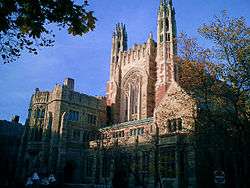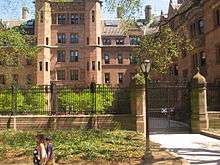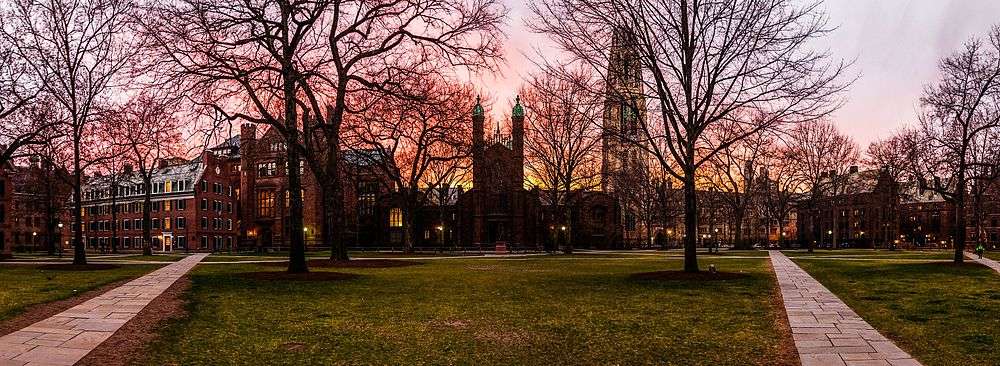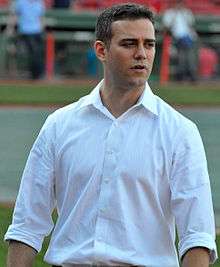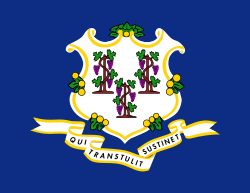Yale University
Yale University is a private Ivy League research university in New Haven, Connecticut. Founded in 1701, it is the third-oldest institution of higher education in the United States and one of the nine Colonial Colleges chartered before the American Revolution.[8]
 | |
| Latin: Universitas Yalensis | |
Former names | Collegiate School (1701–1718) Yale College (1718–present) |
|---|---|
| Motto | אורים ותמים (Hebrew) (Urim V'Thummim) Lux et veritas (Latin) |
Motto in English | Light and truth |
| Type | Private |
| Established | October 9, 1701 |
Academic affiliations | AAU IARU NAICU[1] |
| Endowment | $30.31 billion (2019)[2] |
| President | Peter Salovey[3] |
| Provost | Scott Strobel[4] |
Academic staff | 4,410[5] |
| Students | 13,609 (Fall 2019)[6] |
| Undergraduates | 6,092 (Fall 2019)[6] |
| Postgraduates | 7,517 (Fall 2019)[6] |
| Location | , , United States |
| Campus | Urban/college town, 1,015 acres (411 ha) |
| Colors | Yale Blue[7] |
| Nickname | Bulldogs |
Sporting affiliations | NCAA Division I FCS – Ivy League – ECAC Hockey – NEISA |
| Mascot | Handsome Dan |
| Website | yale |
Chartered by Connecticut Colony, the "Collegiate School" was established in 1701 by clergy to educate Congregational ministers. It moved to New Haven in 1716 and shortly after was renamed Yale College in recognition of a gift from British East India Company governor Elihu Yale. Originally restricted to theology and sacred languages, the curriculum began to incorporate humanities and sciences by the time of the American Revolution. In the 19th century, the college expanded into graduate and professional instruction, awarding the first PhD in the United States in 1861 and organizing as a university in 1887.[9] Yale's faculty and student populations grew after 1890 with rapid expansion of the physical campus and scientific research.
Yale is organized into fourteen constituent schools: the original undergraduate college, the Yale Graduate School of Arts and Sciences and twelve professional schools. While the university is governed by the Yale Corporation, each school's faculty oversees its curriculum and degree programs. In addition to a central campus in downtown New Haven, the university owns athletic facilities in western New Haven, a campus in West Haven, Connecticut and forest and nature preserves throughout New England. The university's assets include an endowment valued at $30.3 billion as of September 2019, the second largest endowment of any educational institution in North America.[2] The Yale University Library, serving all constituent schools, holds more than 15 million volumes and is the third-largest academic library in the United States.[10][11]
Yale College undergraduates follow a liberal arts curriculum with departmental majors and are organized into a social system of residential colleges. Almost all members of the Faculty of Arts and Sciences—and some members of other faculties—teach undergraduate courses, more than 2,000 of which are offered annually.[12] Students compete intercollegiately as the Yale Bulldogs in the NCAA Division I – Ivy League.
As of October 2019, 62 Nobel laureates, 5 Fields Medalists and 3 Turing award winners have been affiliated with Yale University. In addition, Yale has graduated many notable alumni, including five U.S. Presidents, 19 U.S. Supreme Court Justices, 31 living billionaires[13] and many heads of state. Hundreds of members of Congress and many U.S. diplomats, 78 MacArthur Fellows,[14] 247 Rhodes Scholars[15] and 119 Marshall Scholars have been affiliated with the university.[16]
History

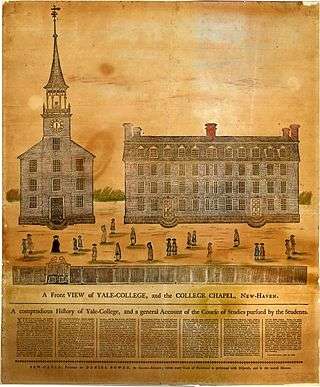
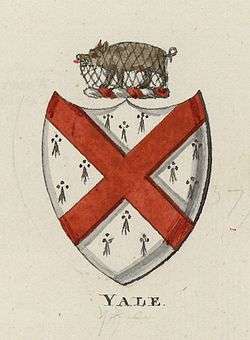
Early history of Yale College
Origins
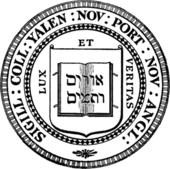
Yale traces its beginnings to "An Act for Liberty to Erect a Collegiate School", passed by the General Court of the Colony of Connecticut on October 9, 1701, while meeting in New Haven. The Act was an effort to create an institution to train ministers and lay leadership for Connecticut. Soon thereafter, a group of ten Congregational ministers, Samuel Andrew, Thomas Buckingham, Israel Chauncy, Samuel Mather (nephew of Increase Mather), Rev. James Noyes II (son of James Noyes), James Pierpont, Abraham Pierson, Noadiah Russell, Joseph Webb, and Timothy Woodbridge, all alumni of Harvard, met in the study of Reverend Samuel Russell in Branford, Connecticut, to pool their books to form the school's library.[17] The group, led by James Pierpont, is now known as "The Founders".[18]
Originally known as the "Collegiate School", the institution opened in the home of its first rector, Abraham Pierson, today considered the first president of Yale. Pierson lived in Killingworth (now Clinton). The school moved to Saybrook and then Wethersfield. In 1716, it moved to New Haven, Connecticut.
Meanwhile, there was a rift forming at Harvard between its sixth president, Increase Mather, and the rest of the Harvard clergy, whom Mather viewed as increasingly liberal, ecclesiastically lax, and overly broad in Church polity. The feud caused the Mathers to champion the success of the Collegiate School in the hope that it would maintain the Puritan religious orthodoxy in a way that Harvard had not.[19]
Naming and development
In 1718, at the behest of either Rector Samuel Andrew or the colony's Governor Gurdon Saltonstall, Cotton Mather contacted the successful Boston born businessman Elihu Yale to ask him for financial help in constructing a new building for the college. Through the persuasion of Jeremiah Dummer, Elihu "Eli" Yale, who had made a fortune while working for the East India Company overseeing its' slave trading activities[20] while living in Madras, donated nine bales of goods, which were sold for more than £560, a substantial sum at the time. Cotton Mather suggested that the school change its name to "Yale College". (The name Yale is the Anglicized spelling of the word Iâl, from the family estate at Plas yn Iâl near the village of Llandegla.)[21]
Meanwhile, a Harvard graduate working in England convinced some 180 prominent intellectuals that they should donate books to Yale. The 1714 shipment of 500 books represented the best of modern English literature, science, philosophy and theology.[22] It had a profound effect on intellectuals at Yale. Undergraduate Jonathan Edwards discovered John Locke's works and developed his original theology known as the "new divinity". In 1722 the Rector and six of his friends, who had a study group to discuss the new ideas, announced that they had given up Calvinism, become Arminians and joined the Church of England. They were ordained in England and returned to the colonies as missionaries for the Anglican faith. Thomas Clapp became president in 1745 and struggled to return the college to Calvinist orthodoxy, but he did not close the library. Other students found Deist books in the library.[23]
Curriculum
Yale was swept up by the great intellectual movements of the period—the Great Awakening and the Enlightenment—due to the religious and scientific interests of presidents Thomas Clap and Ezra Stiles. They were both instrumental in developing the scientific curriculum at Yale while dealing with wars, student tumults, graffiti, "irrelevance" of curricula, desperate need for endowment and fights with the Connecticut legislature.[24]
Serious American students of theology and divinity, particularly in New England, regarded Hebrew as a classical language, along with Greek and Latin, and essential for the study of the Old Testament in the original words. The Reverend Ezra Stiles, president of the College from 1778 to 1795, brought with him his interest in the Hebrew language as a vehicle for studying ancient Biblical texts in their original language (as was common in other schools), requiring all freshmen to study Hebrew (in contrast to Harvard, where only upperclassmen were required to study the language) and is responsible for the Hebrew phrase אורים ותמים (Urim and Thummim) on the Yale seal. A 1746 graduate of Yale, Stiles came to the college with experience in education, having played an integral role in the founding of Brown University in addition to having been a minister.[25] Stiles' greatest challenge occurred in July 1779 when hostile British forces occupied New Haven and threatened to raze the College. However, Yale graduate Edmund Fanning, Secretary to the British General in command of the occupation, interceded and the College was saved. In 1803, Fanning was granted an honorary degree LL.D. for his efforts.[26]

Students
As the only college in Connecticut, Yale educated the sons of the elite.[27] Offenses for which students were punished included cardplaying, tavern-going, destruction of college property, and acts of disobedience to college authorities. During the period, Harvard was distinctive for the stability and maturity of its tutor corps, while Yale had youth and zeal on its side.[28]
The emphasis on classics gave rise to a number of private student societies, open only by invitation, which arose primarily as forums for discussions of modern scholarship, literature and politics. The first such organizations were debating societies: Crotonia in 1738, Linonia in 1753 and Brothers in Unity in 1768.[29]
19th century
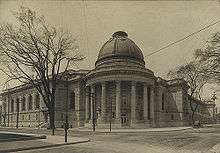
The Yale Report of 1828 was a dogmatic defense of the Latin and Greek curriculum against critics who wanted more courses in modern languages, mathematics, and science. Unlike higher education in Europe, there was no national curriculum for colleges and universities in the United States. In the competition for students and financial support, college leaders strove to keep current with demands for innovation. At the same time, they realized that a significant portion of their students and prospective students demanded a classical background. The Yale report meant the classics would not be abandoned. All institutions experimented with changes in the curriculum, often resulting in a dual-track. In the decentralized environment of higher education in the United States, balancing change with tradition was a common challenge because no one could afford to be completely modern or completely classical.[30][31] A group of professors at Yale and New Haven Congregationalist ministers articulated a conservative response to the changes brought about by the Victorian culture. They concentrated on developing a whole man possessed of religious values sufficiently strong to resist temptations from within, yet flexible enough to adjust to the 'isms' (professionalism, materialism, individualism, and consumerism) tempting him from without.[32] William Graham Sumner, professor from 1872 to 1909, taught in the emerging disciplines of economics and sociology to overflowing classrooms. He bested President Noah Porter, who disliked social science and wanted Yale to lock into its traditions of classical education. Porter objected to Sumner's use of a textbook by Herbert Spencer that espoused agnostic materialism because it might harm students.[33]
Until 1887, the legal name of the university was "The President and Fellows of Yale College, in New Haven". In 1887, under an act passed by the Connecticut General Assembly, Yale gained its current, and shorter, name of "Yale University".[34]
Sports and debate
The Revolutionary War soldier Nathan Hale (Yale 1773) was the prototype of the Yale ideal in the early 19th century: a manly yet aristocratic scholar, equally well-versed in knowledge and sports, and a patriot who "regretted" that he "had but one life to lose" for his country. Western painter Frederic Remington (Yale 1900) was an artist whose heroes gloried in combat and tests of strength in the Wild West. The fictional, turn-of-the-20th-century Yale man Frank Merriwell embodied the heroic ideal without racial prejudice, and his fictional successor Frank Stover in the novel Stover at Yale (1911) questioned the business mentality that had become prevalent at the school. Increasingly the students turned to athletic stars as their heroes, especially since winning the big game became the goal of the student body, and the alumni, as well as the team itself.[35]
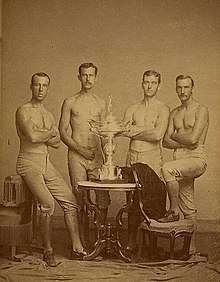
Along with Harvard and Princeton, Yale students rejected elite British concepts about 'amateurism' in sports and constructed athletic programs that were uniquely American, such as football.[36] The Harvard–Yale football rivalry began in 1875. Between 1892, when Harvard and Yale met in one of the first intercollegiate debates[37] and 1909 (the year of the first Triangular Debate of Harvard, Yale and Princeton) the rhetoric, symbolism, and metaphors used in athletics were used to frame these early debates. Debates were covered on front pages of college newspapers and emphasized in yearbooks, and team members even received the equivalent of athletic letters for their jackets. There even were rallies sending off the debating teams to matches, but the debates never attained the broad appeal that athletics enjoyed. One reason may be that debates do not have a clear winner, as is the case in sports, and that scoring is subjective. In addition, with late 19th-century concerns about the impact of modern life on the human body, athletics offered hope that neither the individual nor the society was coming apart.[38]
In 1909–10, football faced a crisis resulting from the failure of the previous reforms of 1905–06 to solve the problem of serious injuries. There was a mood of alarm and mistrust, and, while the crisis was developing, the presidents of Harvard, Yale, and Princeton developed a project to reform the sport and forestall possible radical changes forced by government upon the sport. President Arthur Hadley of Yale, A. Lawrence Lowell of Harvard, and Woodrow Wilson of Princeton worked to develop moderate changes to reduce injuries. Their attempts, however, were reduced by rebellion against the rules committee and formation of the Intercollegiate Athletic Association. The big three had tried to operate independently of the majority, but changes did reduce injuries.[39]
Expansion
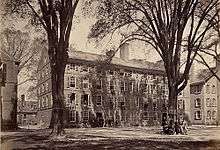
Yale expanded gradually, establishing the Yale School of Medicine (1810), Yale Divinity School (1822), Yale Law School (1843), Yale Graduate School of Arts and Sciences (1847), the Sheffield Scientific School (1847),[40] and the Yale School of Fine Arts (1869). In 1887, as the college continued to grow under the presidency of Timothy Dwight V, Yale College was renamed Yale University, with the name Yale College subsequently applied to the undergraduate college. The university would later add the Yale School of Music (1894), the Yale School of Forestry & Environmental Studies (founded by Gifford Pinchot in 1900), the Yale School of Public Health (1915), the Yale School of Nursing (1923), the Yale School of Drama(1955), the Yale Physician Associate Program (1973), the Yale School of Management (1976), and the Jackson School of Global Affairs which will open in 2022.[41] It would also reorganize its relationship with the Sheffield Scientific School.
Expansion caused controversy about Yale's new roles. Noah Porter, moral philosopher, was president from 1871 to 1886. During an age of tremendous expansion in higher education, Porter resisted the rise of the new research university, claiming that an eager embrace of its ideals would corrupt undergraduate education. Many of Porter's contemporaries criticized his administration, and historians since have disparaged his leadership. Levesque argues Porter was not a simple-minded reactionary, uncritically committed to tradition, but a principled and selective conservative.[42] He did not endorse everything old or reject everything new; rather, he sought to apply long-established ethical and pedagogical principles to a rapidly changing culture. He may have misunderstood some of the challenges of his time, but he correctly anticipated the enduring tensions that have accompanied the emergence and growth of the modern university.
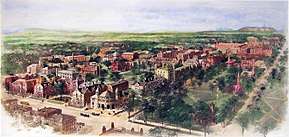
20th century
Behavioral sciences
Between 1925 and 1940, philanthropic foundations, especially ones connected with the Rockefellers, contributed about $7 million to support the Yale Institute of Human Relations and the affiliated Yerkes Laboratories of Primate Biology. The money went toward behavioral science research, which was supported by foundation officers who aimed to "improve mankind" under an informal, loosely defined human engineering effort. The behavioral scientists at Yale, led by President James R. Angell and psychobiologist Robert M. Yerkes, tapped into foundation largesse by crafting research programs aimed to investigate, then suggest, ways to control sexual and social behavior. For example, Yerkes analyzed chimpanzee sexual behavior in hopes of illuminating the evolutionary underpinnings of human development and providing information that could ameliorate dysfunction. Ultimately, the behavioral-science results disappointed foundation officers, who shifted their human-engineering funds toward biological sciences.[43]
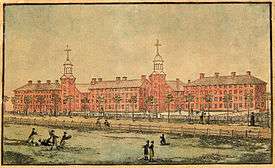
Biology
Slack (2003) compares three groups that conducted biological research at Yale during overlapping periods between 1910 and 1970. Yale proved important as a site for this research. The leaders of these groups were Ross Granville Harrison, Grace E. Pickford, and G. Evelyn Hutchinson, and their members included both graduate students and more experienced scientists. All produced innovative research, including the opening of new subfields in embryology, endocrinology, and ecology, respectively, over a long period of time. Harrison's group is shown to have been a classic research school; Pickford's and Hutchinson's were not. Pickford's group was successful in spite of her lack of departmental or institutional position or power. Hutchinson and his graduate and postgraduate students were extremely productive, but in diverse areas of ecology rather than one focused area of research or the use of one set of research tools. Hutchinson's example shows that new models for research groups are needed, especially for those that include extensive field research.[44]
Medicine
Milton Winternitz led the Yale School of Medicine as its dean from 1920 to 1935. Dedicated to the new scientific medicine established in Germany, he was equally fervent about "social medicine" and the study of humans in their culture and environment. He established the "Yale System" of teaching, with few lectures and fewer exams, and strengthened the full-time faculty system; he also created the graduate-level Yale School of Nursing and the Psychiatry Department and built numerous new buildings. Progress toward his plans for an Institute of Human Relations, envisioned as a refuge where social scientists would collaborate with biological scientists in a holistic study of humankind, unfortunately, lasted for only a few years before the opposition of resentful anti-Semitic colleagues drove him to resign.[45]
Faculty
Before World War II, most elite university faculties counted among their numbers few, if any, Jews, blacks, women, or other minorities; Yale was no exception. By 1980, this condition had been altered dramatically, as numerous members of those groups held faculty positions.[46]
History and American studies
The American studies program reflected the worldwide anti-Communist ideological struggle. Norman Holmes Pearson, who worked for the Office of Strategic Studies in London during World War II, returned to Yale and headed the new American studies program, in which scholarship quickly became an instrument of promoting liberty. Popular among undergraduates, the program sought to instruct them in the fundamentals of American civilization and thereby instill a sense of nationalism and national purpose.[47] Also during the 1940s and 1950s, Wyoming millionaire William Robertson Coe made large contributions to the American studies programs at Yale University and at the University of Wyoming. Coe was concerned to celebrate the 'values' of the Western United States in order to meet the "threat of communism".[48]
Women
In 1793, Lucinda Foote passed the entrance exams for Yale College, but was rejected by the President on the basis of her gender.[49] Women studied at Yale University as early as 1892, in graduate-level programs at the Yale Graduate School of Arts and Sciences.[50]
In 1966, Yale began discussions with its sister school Vassar College about merging to foster coeducation at the undergraduate level. Vassar, then all-female and part of the Seven Sisters—elite higher education schools that historically served as sister institutions to the Ivy League when most Ivy League institutions still only admitted men—tentatively accepted, but then declined the invitation. Both schools introduced coeducation independently in 1969.[51] Amy Solomon was the first woman to register as a Yale undergraduate;[52] she was also the first woman at Yale to join an undergraduate society, St. Anthony Hall. The undergraduate class of 1973 was the first class to have women starting from freshman year;[53] at the time, all undergraduate women were housed in Vanderbilt Hall at the south end of Old Campus.[54]
A decade into co-education, student assault and harassment by faculty became the impetus for the trailblazing lawsuit Alexander v. Yale. While unsuccessful in the courts, the legal reasoning behind the case changed the landscape of sex discrimination law and resulted in the establishment of Yale's Grievance Board and the Yale Women's Center.[55] In March 2011 a Title IX complaint was filed against Yale by students and recent graduates, including editors of Yale's feminist magazine Broad Recognition, alleging that the university had a hostile sexual climate.[56] In response, the university formed a Title IX steering committee to address complaints of sexual misconduct.[57]
Class
Yale, like other Ivy League schools, instituted policies in the early 20th century designed to maintain the proportion of white Protestants from notable families in the student body (see numerus clausus), and was one of the last of the Ivies to eliminate such preferences, beginning with the class of 1970.[58]
Town–gown relations
Yale has a complicated relationship with its home city; for example, thousands of students volunteer every year in a myriad of community organizations, but city officials, who decry Yale's exemption from local property taxes, have long pressed the university to do more to help. Under President Levin, Yale has financially supported many of New Haven's efforts to reinvigorate the city. Evidence suggests that the town and gown relationships are mutually beneficial. Still, the economic power of the university increased dramatically with its financial success amid a decline in the local economy.[59]
21st century
In 2006, Yale and Peking University (PKU) established a Joint Undergraduate Program in Beijing, an exchange program allowing Yale students to spend a semester living and studying with PKU honor students.[60] In July 2012, the Yale University-PKU Program ended due to weak participation.[60]
In 2007 outgoing Yale President Rick Levin characterized Yale's institutional priorities: "First, among the nation's finest research universities, Yale is distinctively committed to excellence in undergraduate education. Second, in our graduate and professional schools, as well as in Yale College, we are committed to the education of leaders."[61]
President George W. Bush, a Yale alumnus, criticized the university for the snobbery and intellectual arrogance he encountered as a student there.[62][63]
The Boston Globe wrote that "if there's one school that can lay claim to educating the nation's top national leaders over the past three decades, it's Yale".[64] Yale alumni were represented on the Democratic or Republican ticket in every U.S. Presidential election between 1972 and 2004. Yale-educated Presidents since the end of the Vietnam War include Gerald Ford, George H.W. Bush, Bill Clinton, and George W. Bush, and major-party nominees during this period include Hillary Clinton (2016), John Kerry (2004), Joseph Lieberman (Vice President, 2000), and Sargent Shriver (Vice President, 1972). Other Yale alumni who made serious bids for the Presidency during this period include Howard Dean (2004), Gary Hart (1984 and 1988), Paul Tsongas (1992), Pat Robertson (1988) and Jerry Brown (1976, 1980, 1992).
Several explanations have been offered for Yale's representation in national elections since the end of the Vietnam War. Various sources note the spirit of campus activism that has existed at Yale since the 1960s, and the intellectual influence of Reverend William Sloane Coffin on many of the future candidates.[65] Yale President Richard Levin attributes the run to Yale's focus on creating "a laboratory for future leaders," an institutional priority that began during the tenure of Yale Presidents Alfred Whitney Griswold and Kingman Brewster.[65] Richard H. Brodhead, former dean of Yale College and now president of Duke University, stated: "We do give very significant attention to orientation to the community in our admissions, and there is a very strong tradition of volunteerism at Yale."[64] Yale historian Gaddis Smith notes "an ethos of organized activity" at Yale during the 20th century that led John Kerry to lead the Yale Political Union's Liberal Party, George Pataki the Conservative Party, and Joseph Lieberman to manage the Yale Daily News.[66] Camille Paglia points to a history of networking and elitism: "It has to do with a web of friendships and affiliations built up in school."[67] CNN suggests that George W. Bush benefited from preferential admissions policies for the "son and grandson of alumni", and for a "member of a politically influential family".[68] New York Times correspondent Elisabeth Bumiller and The Atlantic Monthly correspondent James Fallows credit the culture of community and cooperation that exists between students, faculty, and administration, which downplays self-interest and reinforces commitment to others.[69]
During the 1988 presidential election, George H. W. Bush (Yale '48) derided Michael Dukakis for having "foreign-policy views born in Harvard Yard's boutique". When challenged on the distinction between Dukakis' Harvard connection and his own Yale background, he said that, unlike Harvard, Yale's reputation was "so diffuse, there isn't a symbol, I don't think, in the Yale situation, any symbolism in it" and said Yale did not share Harvard's reputation for "liberalism and elitism".[70][71] In 2004 Howard Dean stated, "In some ways, I consider myself separate from the other three (Yale) candidates of 2004. Yale changed so much between the class of '68 and the class of '71. My class was the first class to have women in it; it was the first class to have a significant effort to recruit African Americans. It was an extraordinary time, and in that span of time is the change of an entire generation".[72]
In 2009, former British Prime Minister Tony Blair picked Yale as one location – the others are Britain's Durham University and Universiti Teknologi Mara – for the Tony Blair Faith Foundation's United States Faith and Globalization Initiative.[73] As of 2009, former Mexican President Ernesto Zedillo is the director of the Yale Center for the Study of Globalization and teaches an undergraduate seminar, "Debating Globalization".[74] As of 2009, former presidential candidate and DNC chair Howard Dean teaches a residential college seminar, "Understanding Politics and Politicians".[75] Also in 2009, an alliance was formed among Yale, University College London, and both schools' affiliated hospital complexes to conduct research focused on the direct improvement of patient care—a growing field known as translational medicine. President Richard Levin noted that Yale has hundreds of other partnerships across the world, but "no existing collaboration matches the scale of the new partnership with UCL".[76]
The most ambitious international partnership to date is Yale-NUS College in Singapore, a joint effort with the National University of Singapore to create a new liberal arts college in Asia featuring an innovative curriculum that weaves Western and Asian traditions, which opened in August 2013.[77][78][79]
Administration and organization
Leadership
| School founding | |
|---|---|
| School | Year founded |
| Yale College | 1701 |
| Yale School of Medicine | 1810 |
| Yale Divinity School | 1822 |
| Yale Law School | 1843 |
| Yale Graduate School of Arts and Sciences | 1847 |
| Sheffield Scientific School[40] | 1847 |
| Yale School of Fine Arts | 1869 |
| Yale School of Music | 1894 |
| Yale School of Forestry & Environmental Studies | 1900 |
| Yale School of Public Health | 1915 |
| Yale School of Architecture | 1916 |
| Yale School of Nursing | 1923 |
| Yale School of Drama | 1955 |
| Yale School of Management | 1976 |
| Jackson School of Global Affairs | 2022[41] |
The President and Fellows of Yale College, also known as the Yale Corporation, is the governing board of the university.
Yale's former president Richard C. Levin was, at the time, one of the highest paid university presidents in the United States with a 2008 salary of $1.5 million.[80]
The Yale Provost's Office has launched several women into prominent university presidencies. In 1977 Hanna Holborn Gray was appointed acting President of Yale from this position, and went on to become President of the University of Chicago, the first woman to be full president of a major university. In 1994 Yale Provost Judith Rodin became the first female president of an Ivy League institution at the University of Pennsylvania. In 2002 Provost Alison Richard became the Vice-Chancellor of the University of Cambridge. In 2004, Provost Susan Hockfield became the President of the Massachusetts Institute of Technology. In 2007 Deputy Provost H. Kim Bottomly was named President of Wellesley College. In 2003, the Dean of the Divinity School, Rebecca Chopp, was appointed president of Colgate University and now heads Swarthmore College.
The university has three major academic components: Yale College (the undergraduate program), the Graduate School of Arts and Sciences, and the professional schools.[81] In 2008 Provost Andrew Hamilton was confirmed to be the Vice Chancellor of the University of Oxford.[82] Former Dean of Yale College Richard H. Brodhead serves as the President of Duke University.
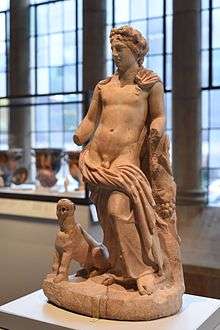
Staff and labor unions
Much of Yale University's staff, including most maintenance staff, dining hall employees and administrative staff, are unionized. Clerical and technical employees are represented by Local 34 of UNITE HERE and service and maintenance workers by Local 35 of the same international. Locals 34 and 35 make up the Federation of Hospital and University Employees along with the dietary workers at Yale–New Haven Hospital, who are members of 1199 SEIU.[83] In addition to these unions, officers of the Yale University Police Department are members of the Yale Police Benevolent Association, which affiliated in 2005 with the Connecticut Organization for Public Safety Employees.[84] Finally, Yale security officers voted to join the International Union of Security, Police and Fire Professionals of America in fall 2010 after the National Labor Relations Board ruled they could not join AFSCME; the Yale administration contested the election.[85]
Yale has a history of difficult and prolonged labor negotiations, often culminating in strikes.[86] There have been at least eight strikes since 1968, and The New York Times wrote that Yale has a reputation as having the worst record of labor tension of any university in the U.S.[87] Yale's unusually large endowment exacerbates the tension over wages. Moreover, Yale has been accused of failing to treat workers with respect.[88] In a 2003 strike, however, the university claimed that more union employees were working than striking.[89] Professor David Graeber was 'retired' after he came to the defense of a student who was involved in campus labor issues.[90]
Campus
Yale's central campus in downtown New Haven covers 260 acres (1.1 km2) and comprises its main, historic campus and a medical campus adjacent to the Yale–New Haven Hospital. In western New Haven, the university holds 500 acres (2.0 km2) of athletic facilities, including the Yale Golf Course.[91] In 2008, Yale purchased the 136-acre (0.55 km2) former Bayer Pharmaceutical campus in West Haven, Connecticut, the buildings of which are now used as laboratory and research space. Yale also owns seven forests in Connecticut, Vermont, and New Hampshire—the largest of which is the 7,840-acre (31.7 km2) Yale-Myers Forest in Connecticut's Quiet Corner—and nature preserves including Horse Island.[92]
Yale is noted for its largely Collegiate Gothic campus[93] as well as several iconic modern buildings commonly discussed in architectural history survey courses: Louis Kahn's Yale Art Gallery[94] and Center for British Art, Eero Saarinen's Ingalls Rink and Ezra Stiles and Morse Colleges, and Paul Rudolph's Art & Architecture Building. Yale also owns and has restored many noteworthy 19th-century mansions along Hillhouse Avenue, which was considered the most beautiful street in America by Charles Dickens when he visited the United States in the 1840s. In 2011, Travel+Leisure listed the Yale campus as one of the most beautiful in the United States.[95]
Many of Yale's buildings were constructed in the Collegiate Gothic architecture style from 1917 to 1931, financed largely by Edward S. Harkness, including the Yale Drama School.[96][97] Stone sculpture built into the walls of the buildings portray contemporary college personalities such as a writer, an athlete, a tea-drinking socialite, and a student who has fallen asleep while reading. Similarly, the decorative friezes on the buildings depict contemporary scenes such as policemen chasing a robber and arresting a prostitute (on the wall of the Law School), or a student relaxing with a mug of beer and a cigarette. The architect, James Gamble Rogers, faux-aged these buildings by splashing the walls with acid,[98] deliberately breaking their leaded glass windows and repairing them in the style of the Middle Ages, and creating niches for decorative statuary but leaving them empty to simulate loss or theft over the ages. In fact, the buildings merely simulate Middle Ages architecture, for though they appear to be constructed of solid stone blocks in the authentic manner, most actually have steel framing as was commonly used in 1930. One exception is Harkness Tower, 216 feet (66 m) tall, which was originally a free-standing stone structure. It was reinforced in 1964 to allow the installation of the Yale Memorial Carillon.
Other examples of the Gothic (also called neo-Gothic and collegiate Gothic) style are on Old Campus by such architects as Henry Austin, Charles C. Haight and Russell Sturgis. Several are associated with members of the Vanderbilt family, including Vanderbilt Hall,[99] Phelps Hall,[100] St. Anthony Hall (a commission for member Frederick William Vanderbilt), the Mason, Sloane and Osborn laboratories, dormitories for the Sheffield Scientific School (the engineering and sciences school at Yale until 1956) and elements of Silliman College, the largest residential college.[101]
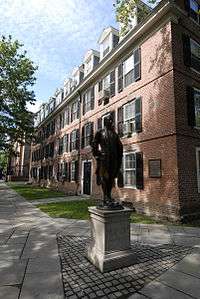
The oldest building on campus, Connecticut Hall (built in 1750), is in the Georgian style. Georgian-style buildings erected from 1929 to 1933 include Timothy Dwight College, Pierson College, and Davenport College, except the latter's east, York Street façade, which was constructed in the Gothic style so as to coordinate with adjacent structures.
The Beinecke Rare Book and Manuscript Library, designed by Gordon Bunshaft of Skidmore, Owings & Merrill, is one of the largest buildings in the world reserved exclusively for the preservation of rare books and manuscripts.[102] It is located near the center of the university in Hewitt Quadrangle, which is now more commonly referred to as "Beinecke Plaza".
The library's six-story above-ground tower of book stacks is surrounded by a windowless rectangular building with walls made of translucent Vermont marble, which transmit subdued lighting to the interior and provide protection from direct light while glowing from within after dark.
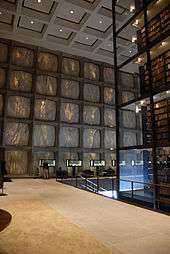
The sculptures in the sunken courtyard by Isamu Noguchi are said to represent time (the pyramid), the sun (the circle), and chance (the cube).
Alumnus Eero Saarinen, Finnish-American architect of such notable structures as the Gateway Arch in St. Louis, Washington Dulles International Airport main terminal, Bell Labs Holmdel Complex and the CBS Building in Manhattan, designed Ingalls Rink at Yale and the residential colleges Ezra Stiles and Morse. These latter were modeled after the medieval Italian hilltown of San Gimignano – a prototype chosen for the town's pedestrian-friendly milieu and fortress-like stone towers. These tower forms at Yale act in counterpoint to the college's many Gothic spires and Georgian cupolas.[103]
Yale's Office of Sustainability develops and implements sustainability practices at Yale.[104] Yale is committed to reduce its greenhouse gas emissions 10% below 1990 levels by the year 2020. As part of this commitment, the university allocates renewable energy credits to offset some of the energy used by residential colleges.[105] Eleven campus buildings are candidates for LEED design and certification.[106] Yale Sustainable Food Project initiated the introduction of local, organic vegetables, fruits, and beef to all residential college dining halls.[107] Yale was listed as a Campus Sustainability Leader on the Sustainable Endowments Institute's College Sustainability Report Card 2008, and received a "B+" grade overall.[108]
- Grove Street Cemetery, New Haven
- Marsh Botanical Garden
- Yale Sustainable Food Program Farm
Notable nonresidential campus buildings
Notable nonresidential campus buildings and landmarks include Battell Chapel, Beinecke Rare Book Library, Harkness Tower, Ingalls Rink, Kline Biology Tower, Osborne Memorial Laboratories, Payne Whitney Gymnasium, Peabody Museum of Natural History, Sterling Hall of Medicine, Sterling Law Buildings, Sterling Memorial Library, Woolsey Hall, Yale Center for British Art, Yale University Art Gallery, Yale Art & Architecture Building, and the Paul Mellon Centre for Studies in British Art in London.
Yale's secret society buildings (some of which are called "tombs") were built both to be private yet unmistakable. A diversity of architectural styles is represented: Berzelius, Donn Barber in an austere cube with classical detailing (erected in 1908 or 1910); Book and Snake, Louis R. Metcalfe in a Greek Ionic style (erected in 1901); Elihu, architect unknown but built in a Colonial style (constructed on an early 17th-century foundation although the building is from the 18th century); Mace and Chain, in a late colonial, early Victorian style (built in 1823). (Interior moulding is said to have belonged to Benedict Arnold);Manuscript Society, King Lui-Wu with Dan Kniley responsible for landscaping and Josef Albers for the brickwork intaglio mural. Building constructed in a mid-century modern style; Scroll and Key, Richard Morris Hunt in a Moorish- or Islamic-inspired Beaux-Arts style (erected 1869–70); Skull and Bones, possibly Alexander Jackson Davis or Henry Austin in an Egypto-Doric style utilizing Brownstone (in 1856 the first wing was completed, in 1903 the second wing, 1911 the Neo-Gothic towers in rear garden were completed); St. Elmo, (former tomb) Kenneth M. Murchison, 1912, designs inspired by Elizabethan manor. Current location, brick colonial; and Wolf's Head, Bertram Grosvenor Goodhue, erected 1923–1924, Collegiate Gothic.
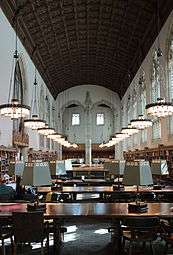 The Starr Reading Room in Sterling Memorial Library
The Starr Reading Room in Sterling Memorial Library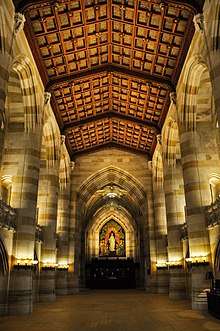 The nave of Sterling Memorial Library
The nave of Sterling Memorial Library- Harkness Tower
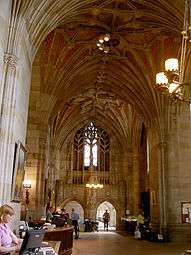 The Library Circulation Desk
The Library Circulation Desk- Memorial Chapel on Yale's Old Campus
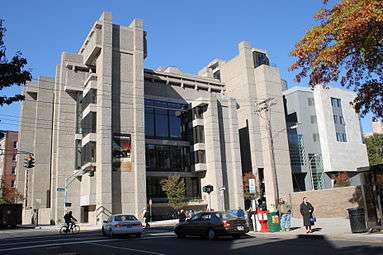 Yale School of Architecture
Yale School of Architecture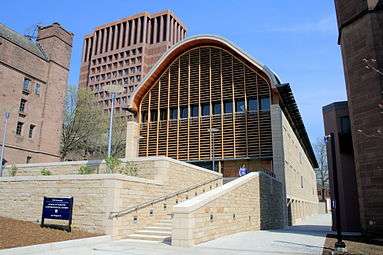 Yale School of Forestry & Environmental Studies
Yale School of Forestry & Environmental Studies.jpg) Connecticut Hall
Connecticut Hall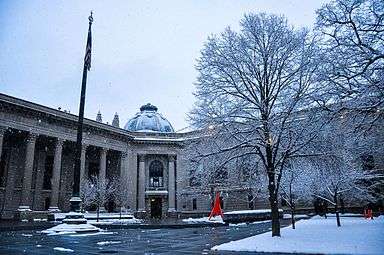 Hewitt Quadrangle
Hewitt Quadrangle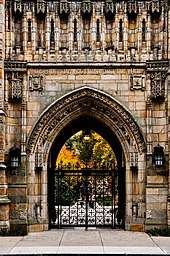 Memorial Quadrangle Gate
Memorial Quadrangle Gate- Yale Peabody Museum
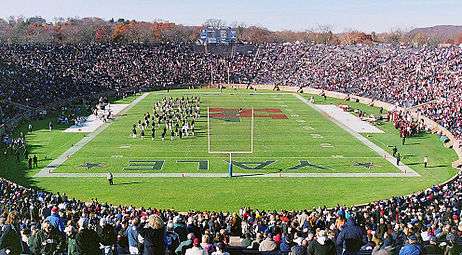 The Yale Bowl
The Yale Bowl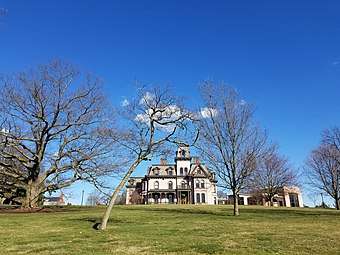 Maurice R. Greenberg Conference Center
Maurice R. Greenberg Conference Center
Relationship with New Haven
Yale is the largest taxpayer and employer in the City of New Haven,[109] and has often buoyed the city's economy and communities. Yale, however has consistently opposed paying a tax on its academic property.[110] Yale's Art Galleries, along with many other university resources, are free and openly accessible. Yale also funds the New Haven Promise program, paying full tuition for eligible students from New Haven public schools.[111]
Campus safety
Several campus safety strategies have been pioneered at Yale. The first campus police force was founded at Yale in 1894, when the university contracted city police officers to exclusively cover the campus.[112][113] Later hired by the university, the officers were originally brought in to quell unrest between students and city residents and curb destructive student behavior.[114][115] In addition to the Yale Police Department, a variety of safety services are available including blue phones, a safety escort, and 24-hour shuttle service.
In the 1970s and 1980s, poverty and violent crime rose in New Haven, dampening Yale's student and faculty recruiting efforts.[116] Between 1990 and 2006, New Haven's crime rate fell by half, helped by a community policing strategy by the New Haven Police and Yale's campus became the safest among the Ivy League and other peer schools.[117] Nonetheless, across the board, the city of New Haven has retained the highest levels of crime of any Ivy League city for more than a decade.
In 2004, the national non-profit watchdog group Security on Campus filed a complaint with the U.S. Department of Education, accusing Yale of under-reporting rape and sexual assaults.[118][119]
Academics
Admissions
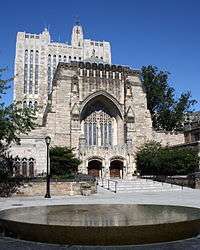
| 2019[120] | 2018[121] | 2017[122] | 2016[123] | 2015[124] | 2014[125] | 2013[126] | |
|---|---|---|---|---|---|---|---|
| Applicants | 36,844 | 35,307 | 32,914 | 31,455 | 30,236 | 30,932 | 29,610 |
| Admits | 2,214 | 2,178 | 2,285 | 1,988 | 2,034 | 1,950 | 2,031 |
| Admit rate | 6.0% | 6.2% | 6.9% | 6.3% | 6.7% | 6.3% | 6.9% |
| Enrolled | 1,550 | 1,573 | 1,579 | 1,373 | 1,364 | 1,360 | 1,359 |
| SAT range | 1470-1560 | 1450-1560 | 1420–1590 | 2130–2390 | 2140–2390 | 2120–2390 | 2140–2390 |
| ACT range | 33-35 | 33-35 | 32–35 | 32–35 | 31–35 | 31–35 | 31–35 |
Undergraduate admission to Yale College is considered "most selective" by U.S. News.[127][128] In 2017, Yale accepted 2,285 students to the Class of 2021 out of 32,914 applicants, for an acceptance rate of 6.9%.[129] 98% of students graduate within six years.[130]
Through its program of need-based financial aid, Yale commits to meet the full demonstrated financial need of all applicants. Most financial aid is in the form of grants and scholarships that do not need to be paid back to the university, and the average need-based aid grant for the Class of 2017 was $46,395.[131] 15% of Yale College students are expected to have no parental contribution, and about 50% receive some form of financial aid.[130][132][133] About 16% of the Class of 2013 had some form of student loan debt at graduation, with an average debt of $13,000 among borrowers.[130]
Half of all Yale undergraduates are women, more than 39% are ethnic minority U.S. citizens (19% are underrepresented minorities), and 10.5% are international students.[131] 55% attended public schools and 45% attended private, religious, or international schools, and 97% of students were in the top 10% of their high school class.[130] Every year, Yale College also admits a small group of non-traditional students through the Eli Whitney Students Program.
In 1999, about 29% of Yale students were Jewish.[134]
Collections
_by_Vincent_van_Gogh.jpeg)
Yale University Library, which holds over 15 million volumes, is the third-largest university collection in the United States.[10][135] The main library, Sterling Memorial Library, contains about 4 million volumes, and other holdings are dispersed at subject libraries.
Rare books are found in several Yale collections. The Beinecke Rare Book Library has a large collection of rare books and manuscripts. The Harvey Cushing/John Hay Whitney Medical Library includes important historical medical texts, including an impressive collection of rare books, as well as historical medical instruments. The Lewis Walpole Library contains the largest collection of 18th‑century British literary works. The Elizabethan Club, technically a private organization, makes its Elizabethan folios and first editions available to qualified researchers through Yale.
Yale's museum collections are also of international stature. The Yale University Art Gallery, the country's first university-affiliated art museum, contains more than 200,000 works, including Old Masters and important collections of modern art, in the Swartout and Kahn buildings. The latter, Louis Kahn's first large-scale American work (1953), was renovated and reopened in December 2006. The Yale Center for British Art, the largest collection of British art outside of the UK, grew from a gift of Paul Mellon and is housed in another Kahn-designed building.
The Peabody Museum of Natural History in New Haven is used by school children and contains research collections in anthropology, archaeology, and the natural environment. The Yale University Collection of Musical Instruments, affiliated with the Yale School of Music, is perhaps the least-known of Yale's collections because its hours of opening are restricted.
The museums once housed the artifacts brought to the United States from Peru by Yale history professor Hiram Bingham in his Yale-financed expedition to Machu Picchu in 1912 – when the removal of such artifacts was legal. The artifacts were restored to Peru in 2012.[136]
Rankings
| University rankings | |
|---|---|
| National | |
| ARWU[137] | 9-10 |
| Forbes[138] | 3 |
| Times/WSJ[139] | 3 |
| U.S. News & World Report[140] | 3 |
| Washington Monthly[141] | 4 |
| Global | |
| ARWU[142] | 11 |
| QS[143] | 17 |
| Times[144] | 8 |
| U.S. News & World Report[145] | 12 |
|
USNWR graduate school rankings[146] | |
|---|---|
| Business | 9 |
| Engineering | 39 |
| Law | 1 |
| Medicine: Primary Care | 49 |
| Medicine: Research | 15 |
| Nursing: Doctorate | 17 |
| Nursing: Master's | 14 |
|
USNWR departmental rankings[146] | |
|---|---|
| Biological Sciences | 6 |
| Chemistry | 9 |
| Clinical Psychology | 18 |
| Computer Science | 20 |
| Earth Sciences | 13 |
| Economics | 1 |
| English | 8 |
| Fine Arts | 2 |
| History | 1 |
| Mathematics | 9 |
| Nursing–Midwifery | 2 |
| Physician Assistant | 26 |
| Physics | 12 |
| Political Science | 4 |
| Psychology | 3 |
| Public Health | 15 |
| Sociology | 22 |
| Statistics | 31 |
The U.S. News & World Report ranked Yale 3rd among U.S. national universities for 2016,[127] as it had for each of the previous sixteen years.
Internationally, Yale was ranked 11th in the 2016 Academic Ranking of World Universities, 10th in the 2016-17 Nature Index[147] for quality of scientific research output, and 10th in the 2016 CWUR World University Rankings.[148] The university was also ranked 6th in the 2016 Times Higher Education (THE) Global University Employability Rankings[149] and 8th in the THE Academic World Reputation Rankings.[150] In 2019, it ranked 25th among the universities around the world by SCImago Institutions Rankings.[151]
Faculty, research, and intellectual traditions
Yale's faculty include 61 members of the National Academy of Sciences,[152] 7 members of the National Academy of Engineering[153] and 49 members of the American Academy of Arts and Sciences. The college is, after normalization for institution size, the tenth-largest baccalaureate source of doctoral degree recipients in the United States, and the largest such source within the Ivy League.[154]
Yale's English and Comparative Literature departments were part of the New Criticism movement. Of the New Critics, Robert Penn Warren, W.K. Wimsatt, and Cleanth Brooks were all Yale faculty. Later, the Yale Comparative literature department became a center of American deconstruction. Jacques Derrida, the father of deconstruction, taught at the Department of Comparative Literature from the late seventies to mid-1980s. Several other Yale faculty members were also associated with deconstruction, forming the so-called "Yale School". These included Paul de Man who taught in the Departments of Comparative Literature and French, J. Hillis Miller, Geoffrey Hartman (both taught in the Departments of English and Comparative Literature), and Harold Bloom (English), whose theoretical position was always somewhat specific, and who ultimately took a very different path from the rest of this group. Yale's history department has also originated important intellectual trends. Historians C. Vann Woodward and David Brion Davis are credited with beginning in the 1960s and 1970s an important stream of southern historians; likewise, David Montgomery, a labor historian, advised many of the current generation of labor historians in the country. Yale's Music School and Department fostered the growth of Music Theory in the latter half of the 20th century. The Journal of Music Theory was founded there in 1957; Allen Forte and David Lewin were influential teachers and scholars.
Since summer 2010, Yale has also been host to Yale Publishing Course.
In addition to eminent faculty members, Yale research relies heavily on the presence of roughly 1200 Postdocs from various national and international origin working in the multiple laboratories in the sciences, social sciences, humanities, and professional schools of the university. The university progressively recognized this working force with the recent creation of the Office for Postdoctoral Affairs and the Yale Postdoctoral Association.
Campus life
Yale is a medium-sized research university, most of whose students are in the graduate and professional schools. Undergraduates, or Yale College students, come from a variety of ethnic, national, socioeconomic backgrounds, and personal backgrounds. Of the 2010–2011 freshman class, 10% are non‑U.S. citizens, while 54% went to public high schools.[155]
Residential colleges
Yale's residential college system was established in 1933 by Edward S. Harkness, who admired the social intimacy of Oxford and Cambridge and donated significant funds to found similar colleges at Yale and Harvard. Though Yale's colleges resemble their English precursors organizationally and architecturally, they are dependent entities of Yale College and have limited autonomy. The colleges are led by a head and an academic dean, who reside in the college, and university faculty and affiliates comprise each college's fellowship. Colleges offer their own seminars, social events, and speaking engagements known as "Master's Teas," but do not contain programs of study or academic departments. All other undergraduate courses are taught by the Faculty of Arts and Sciences and are open to members of any college.
All undergraduates are members of a college, to which they are assigned before their freshman year, and 85 percent live in the college quadrangle or a college-affiliated dormitory.[156] While the majority of upperclassman live in the colleges, most on-campus freshmen live on the Old Campus, the university's oldest precinct.
While Harkness' original colleges were Georgian Revival or Collegiate Gothic in style, two colleges constructed in the 1960s, Morse and Ezra Stiles Colleges, have modernist designs. All twelve college quadrangles are organized around a courtyard, and each has a dining hall, courtyard, library, common room, and a range of student facilities. The twelve colleges are named for important alumni or significant places in university history. In 2017, the university opened two new colleges near Science Hill.[157]
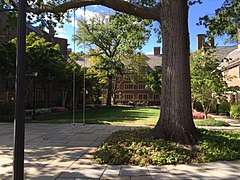 Jonathan Edwards College courtyard
Jonathan Edwards College courtyard- Branford College courtyard
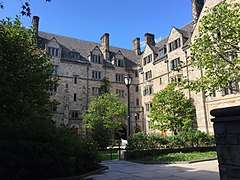 Saybrook College's Killingworth Courtyard
Saybrook College's Killingworth Courtyard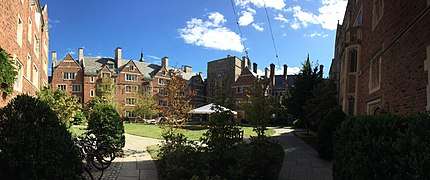 Hopper College courtyard
Hopper College courtyard_at_Yale.jpg) Berkeley College buildings
Berkeley College buildings Trumbull College courtyard
Trumbull College courtyard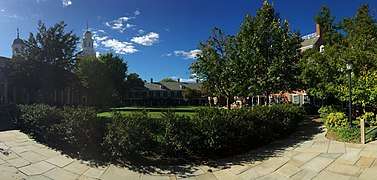 Davenport College courtyard
Davenport College courtyard Pierson College courtyard
Pierson College courtyard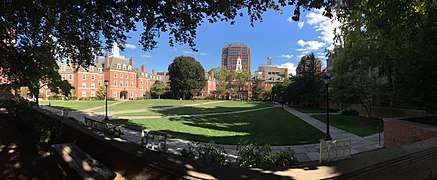 Silliman College courtyard
Silliman College courtyard Timothy Dwight College courtyard
Timothy Dwight College courtyard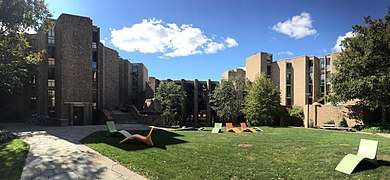 Morse College courtyard
Morse College courtyard Ezra Stiles College courtyard
Ezra Stiles College courtyard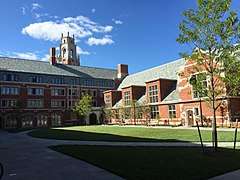 Benjamin Franklin College courtyard
Benjamin Franklin College courtyard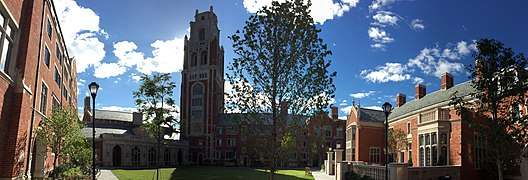 Pauli Murray College courtyard
Pauli Murray College courtyard
Calhoun College
Since the 1960s, John C. Calhoun's white supremacist beliefs and pro-slavery leadership[158][159][160][161] had prompted calls to rename the college or remove its tributes to Calhoun. The racially motivated church shooting in Charleston, South Carolina, led to renewed calls in the summer of 2015 for Calhoun College, one of 12 residential colleges, to be renamed. In July 2015 students signed a petition calling for the name change.[159] They argued in the petition that—while Calhoun was respected in the 19th century as an "extraordinary American statesman"—he was "one of the most prolific defenders of slavery and white supremacy" in the history of the United States.[159][160] In August 2015 Yale President Peter Salovey addressed the Freshman Class of 2019 in which he responded to the racial tensions but explained why the college would not be renamed.[161] He described Calhoun as "a notable political theorist, a vice president to two different U.S. presidents, a secretary of war and of state, and a congressman and senator representing South Carolina".[161] He acknowledged that Calhoun also "believed that the highest forms of civilization depend on involuntary servitude. Not only that, but he also believed that the races he thought to be inferior, black people in particular, ought to be subjected to it for the sake of their own best interests."[158] Student activism about this issue increased in the fall of 2015, and included further protests sparked by controversy surrounding an administrator's comments on the potential positive and negative implications of students who wear culturally sensitive Halloween costumes.[162] Campus-wide discussions expanded to include critical discussion of the experiences of women of color on campus, and the realities of racism in undergraduate life.[163] The protests were sensationalized by the media and led to the labelling of some students as being members of Generation Snowflake.[164]
In April 2016 Salovey announced that "despite decades of vigorous alumni and student protests," Calhoun's name will remain on the Yale residential college[165] explaining that it is preferable for Yale students to live in Calhoun's "shadow" so they will be "better prepared to rise to the challenges of the present and the future". He claimed that if they removed Calhoun's name, it would "obscure" his "legacy of slavery rather than addressing it".[165] "Yale is part of that history" and "We cannot erase American history, but we can confront it, teach it and learn from it." One change that will be issued is the title of "master" for faculty members who serve as residential college leaders will be renamed to "head of college" due to its connotation of slavery.[166]
Despite this apparently conclusive reasoning, Salovey announced that Calhoun College would be renamed for groundbreaking computer scientist Grace Murray Hopper in February 2017.[167] This renaming decision received a range of responses from Yale students and alumni.[168][169][170]
Student organizations
In 2014, Yale had 385 registered student organizations, plus an additional one hundred groups in the process of registration.[171]
The university hosts a variety of student journals, magazines, and newspapers. Established in 1872, The Yale Record is the world's oldest humor magazine. Newspapers include the Yale Daily News, which was first published in 1878, and the weekly Yale Herald, which was first published in 1986. The Yale Journal of Medicine & Law is a biannual magazine that explores the intersection of law and medicine.
Dwight Hall, an independent, non-profit community service organization, oversees more than 2,000 Yale undergraduates working on more than 70 community service initiatives in New Haven. The Yale College Council runs several agencies that oversee campus wide activities and student services. The Yale Dramatic Association and Bulldog Productions cater to the theater and film communities, respectively. In addition, the Yale Drama Coalition[172] serves to coordinate between and provide resources for the various Sudler Fund sponsored theater productions which run each weekend. WYBC Yale Radio[173] is the campus's radio station, owned and operated by students. While students used to broadcast on AM and FM frequencies, they now have an Internet-only stream.
The Yale College Council (YCC) serves as the campus's undergraduate student government. All registered student organizations are regulated and funded by a subsidiary organization of the YCC, known as the Undergraduate Organizations Funding Committee (UOFC).[174] The Graduate and Professional Student Senate (GPSS) serves as Yale's graduate and professional student government.
The Yale Political Union is advised by alumni political leaders such as John Kerry and George Pataki. The Yale International Relations Association (YIRA) functions as the umbrella organization for the top-ranked Model UN team. YIRA also has a Europe-based offshoot, Yale Model Government Europe, other Model UN conferences such as YMUN Korea or YMUN Taiwan, and educational programs such as the Yale Review of International Relations (YRIS), YMUN Institute, or Hemispheres.
The campus includes several fraternities and sororities. The campus features at least 18 a cappella groups, the most famous of which is The Whiffenpoofs, which from its founding in 1909 until 2018 was made up solely of senior men.
Yale's secret societies include Skull and Bones, Scroll and Key, Wolf's Head, Book and Snake, Elihu, Berzelius, St. Elmo, Manuscript, Shabtai, Myth and Sword, Mace and Chain and Sage and Chalice. The two oldest existing honor societies are the Aurelian (1910) and the Torch Honor Society (1916).[175]
The Elizabethan Club, a social club, has a membership of undergraduates, graduates, faculty and staff with literary or artistic interests. Membership is by invitation. Members and their guests may enter the "Lizzie's" premises for conversation and tea. The club owns first editions of a Shakespeare Folio, several Shakespeare Quartos, and a first edition of Milton's Paradise Lost, among other important literary texts.
Traditions
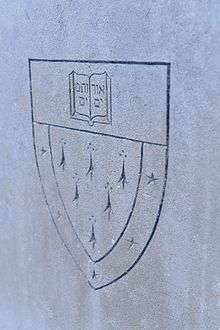
Yale seniors at graduation smash clay pipes underfoot to symbolize passage from their "bright college years," though in recent history the pipes have been replaced with "bubble pipes".[176][177] ("Bright College Years," the University's alma mater, was penned in 1881 by Henry Durand, Class of 1881, to the tune of Die Wacht am Rhein.) Yale's student tour guides tell visitors that students consider it good luck to rub the toe of the statue of Theodore Dwight Woolsey on Old Campus. Actual students rarely do so.[178] In the second half of the 20th century Bladderball, a campus-wide game played with a large inflatable ball, became a popular tradition but was banned by administration due to safety concerns. In spite of administration opposition, students revived the game in 2009, 2011, and 2014, but its future remains uncertain.[179][180]
Athletics
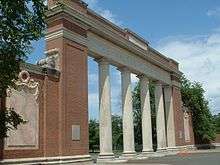
Yale supports 35 varsity athletic teams that compete in the Ivy League Conference, the Eastern College Athletic Conference, the New England Intercollegiate Sailing Association. Yale athletic teams compete intercollegiately at the NCAA Division I level. Like other members of the Ivy League, Yale does not offer athletic scholarships.
Yale has numerous athletic facilities, including the Yale Bowl (the nation's first natural "bowl" stadium, and prototype for such stadiums as the Los Angeles Memorial Coliseum and the Rose Bowl), located at The Walter Camp Field athletic complex, and the Payne Whitney Gymnasium, the second-largest indoor athletic complex in the world.[181]
In May 2018, the men's lacrosse team defeated the Duke Blue Devils to claim their first ever NCAA Division I Men's Lacrosse Championship,[182] and are the first Ivy League school to win the title since the Princeton Tigers in 2001.[183]
In 2016, the men's basketball team won the Ivy League Championship title for the first time in 54 years, earning a spot in the NCAA Men's Division I Basketball Tournament. In the first round of the tournament, the Bulldogs beat the Baylor Bears 79–75 in the school's first-ever tournament win.[184]
October 21, 2000, marked the dedication of Yale's fourth new boathouse in 157 years of collegiate rowing. The Gilder Boathouse is named to honor former Olympic rower Virginia Gilder '79 and her father Richard Gilder '54, who gave $4 million towards the $7.5 million project. Yale also maintains the Gales Ferry site where the heavyweight men's team trains for the Yale-Harvard Boat Race.
Yale crew is the oldest collegiate athletic team in America, and won Olympic Games Gold Medal for men's eights in 1924 and 1956. The Yale Corinthian Yacht Club, founded in 1881, is the oldest collegiate sailing club in the world.
In 1896, Yale and Johns Hopkins played the first known ice hockey game in the United States. Since 2006, the school's ice hockey clubs have played a commemorative game.[185]
For kicks, between 1954 and 1982, residential college teams and student organizations played bladderball.[186]
Yale students claim to have invented Frisbee, by tossing empty Frisbie Pie Company tins.[187][188]
Yale athletics are supported by the Yale Precision Marching Band. "Precision" is used here ironically; the band is a scatter-style band that runs wildly between formations rather than actually marching.[189] The band attends every home football game and many away, as well as most hockey and basketball games throughout the winter.
Yale intramural sports are also a significant aspect of student life. Students compete for their respective residential colleges, fostering a friendly rivalry. The year is divided into fall, winter, and spring seasons, each of which includes about ten different sports. About half the sports are coeducational. At the end of the year, the residential college with the most points (not all sports count equally) wins the Tyng Cup.
Song
Notable among the songs commonly played and sung at events such as commencement, convocation, alumni gatherings, and athletic games are the alma mater, "Bright College Years", and the Yale fight song, "Down the Field".
Two other fight songs, "Bulldog, Bulldog" and "Bingo Eli Yale", written by Cole Porter during his undergraduate days, are still sung at football games. Another fight song sung at games is "Boola Boola". According to College Fight Songs: An Annotated Anthology published in 1998, "Down the Field" ranks as the fourth-greatest fight song of all time.[190]
Mascot
The school mascot is "Handsome Dan," the Yale bulldog, and the Yale fight song (written by Cole Porter while he was a student at Yale) contains the refrain, "Bulldog, bulldog, bow wow wow". The school color, since 1894, is Yale Blue.[191] Yale's Handsome Dan is believed to be the first college mascot in America, having been established in 1889.[192]
Notable people
Benefactors
Yale has had many financial supporters, but some stand out by the magnitude or timeliness of their contributions. Among those who have made large donations commemorated at the university are: Elihu Yale; Jeremiah Dummer; the Harkness family (Edward, Anna, and William); the Beinecke family (Edwin, Frederick, and Walter); John William Sterling; Payne Whitney; Joseph Earl Sheffield, Paul Mellon, Charles B. G. Murphy, Joseph Tsai, and William K. Lanman. The Yale Class of 1954, led by Richard Gilder, donated $70 million in commemoration of their 50th reunion.[193] Charles B. Johnson, a 1954 graduate of Yale College, pledged a $250 million gift in 2013 to support the construction of two new residential colleges.[194] The colleges have been named respectively in honor of Pauli Murray and Benjamin Franklin. A $100 million contribution[195] by Stephen Adams enabled the Yale School of Music to become tuition-free and the Adams Center for Musical Arts to be built.
Notable alumni and faculty
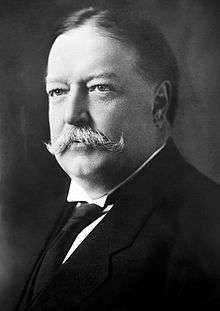
Yale has produced alumni distinguished in their respective fields. This includes U.S. Presidents William Howard Taft, Gerald Ford, George H.W. Bush, Bill Clinton and George W. Bush;[196] heads of state, including Italian prime minister Mario Monti,[197] Turkish prime minister Tansu Çiller,[198] Mexican president Ernesto Zedillo,[199] German president Karl Carstens,[200] Philippine president José Paciano Laurel,[201] Governor-General Francis Burton Harrison,[202] and Malawian president Peter Mutharika;[203] U.S. Supreme Court Justices Taft, Sonia Sotomayor,[204] Samuel Alito,[205] Clarence Thomas,[205] and Brett Kavanaugh; Secretaries of State John Kerry,[206] Hillary Clinton,[207] Cyrus Vance,[208] and Dean Acheson;[209] U.S. Secretaries of the Treasury Oliver Wolcott,[210] Robert Rubin,[211] Nicholas F. Brady,[212] and Steven Mnuchin;[213] and United States Attorneys General Nicholas Katzenbach,[214] John Ashcroft,[215] and Edward H. Levi.[216] Confederate States Secretary of State, Secretary of War, and Attorney General; Judah P. Benjamin.[217]
Some royals have attended, among them: Crown Princess Victoria of Sweden,[218] Olympia Bonaparte, Princess Napoléon, Prince Rostislav Romanov and Prince Akiiki Hosea Nyabongo;
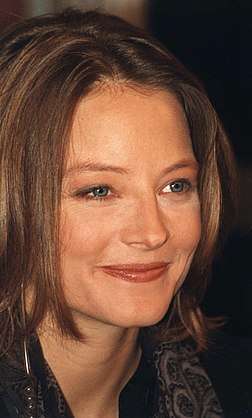
In the arts, Yale alumni include authors Sinclair Lewis, Stephen Vincent Benét, John Hersey, Thornton Wilder, Doug Wright, William Matthews, and Tom Wolfe; actors, directors, playwrights, and producers Tarell Alvin McCraney,[219] Jodie Foster,[220] Paul Newman, Henry Winkler, Vincent Price, Meryl Streep,[221] Sigourney Weaver,[222] Angela Bassett,[223] Elia Kazan, George Roy Hill, Douglas Wick, Claire Danes, Edward Norton, Lupita Nyong'o,[224] James Whitmore, Oliver Stone, Brian Dennehy, Joshua Malina, and Sam Waterston; composers Charles Ives, Douglas Moore and Cole Porter; visual artists Matthew Barney, Eva Hesse, Alex Israel, Robert L. Levers, Jr.,[225] Brice Marden, Wangechi Mutu,[226] Richard Serra, and Kehinde Wiley;[227] fine art photography popularizer Sam Wagstaff; entertainer Rudy Vallee; photographer and writer Nicholas Muellner; and architectural critic Alexandra Lange.
In business, Time magazine co-founder Henry Luce,[228] Morgan Stanley founder Harold Stanley, Blackstone Group founder Stephen A. Schwarzman,[229] Boeing and United Airlines founder William Boeing, FedEx founder Frederick W. Smith, chairman and CEO of Sears Holdings Edward Lampert, Time Warner president Jeffrey Bewkes, Electronic Arts co-founder Bing Gordon, PepsiCo CEO Indra Nooyi, Pinterest co-founder and CEO Ben Silbermann, sports agent Donald Dell, and investor/philanthropist Sir John Templeton all hail from Yale.
In academia, distinguished Yale graduates and faculty have included theologian and religious scholar Kathryn Tanner, philosopher of religion John E. Hare, literary critic and historian Henry Louis Gates, economists Irving Fischer, Mahbub ul Haq, and Paul Krugman; Nobel laureates in Physics, Ernest Lawrence and Murray Gell-Mann; Fields Medalist John G. Thompson; Human Genome Project director Francis S. Collins; "father of biochemistry" Russell Henry Chittenden; neurosurgeon Harvey Cushing; pioneering computer scientist Grace Hopper; chairman of Caltech's Jet Propulsion Laboratory Committee Clark Blanchard Millikan; education philosopher Robert Maynard Hutchins; pioneer in fractal geometry Benoit Mandelbrot; mathematician/chemist Josiah Willard Gibbs; U.S. National Women's Hall of Fame member and biochemist Florence B. Seibert; and anthropologist Sabine Hyland.
Former Yale students in the sporting arena include "The perfect oarsman" Rusty Wailes; Olympic silver medalist rower Josh West; Olympic silver and bronze medalist Sada Jacobson; runner Frank Shorter; baseball executives Theo Epstein and George Weiss, and baseball players Ron Darling, Bill Hutchinson, and Craig Breslow; basketball player Chris Dudley; football players Dick Jauron, Kenny Hill, Calvin Hill, Gary Fencik, Chuck Mercein, Amos Alonzo Stagg, and "Father of American Football" Walter Camp; nine-time U.S. Squash men's champion Julian Illingworth; ice hockey player Chris Higgins; figure skater Sarah Hughes; swimmer Don Schollander; and Olympic figure skater Nathan Chen.
Yale also counts among its former students Secretary of State, Secretary of War and U.S. Senator John C. Calhoun;[230] Peace Corps founder Sargent Shriver; urban planner Robert Moses; child psychologist Benjamin Spock; architects Maya Lin, Eero Saarinen and Norman Foster; television personalities Stone Phillips, Dick Cavett Anderson Cooper, and Jim Scuitto; pundits Garry Trudeau, William F. Buckley, Jr. and Fareed Zakaria; pioneer in electrical applications Austin Cornelius Dunham; inventors Samuel F.B. Morse, Eli Whitney, and John B. Goodenough; patriot and "first spy" Nathan Hale; lexicographer Noah Webster; and theologians Jonathan Edwards and Reinhold Niebuhr.
In fiction and popular culture
Yale University, as one of the oldest universities in the United States, is a cultural referent as an institution that produces some of the most elite members of society[231] and its grounds, alumni, and students have been prominently portrayed in fiction and U.S. popular culture. For example, Owen Johnson's novel, Stover at Yale, follows the college career of Dink Stover,[232] and Frank Merriwell, the model for all later juvenile sports fiction, plays football, baseball, crew, and track at Yale while solving mysteries and righting wrongs.[233][234] Yale University also is mentioned in F. Scott Fitzgerald's novel The Great Gatsby. The narrator, Nick Carraway, wrote a series of editorials for the Yale News, and Tom Buchanan was "one of the most powerful ends that ever played football" for Yale. In the popular TV show The Simpsons, Mr. Burns is a Yale alumnus.
Further reading
- Bagg, Lyman H. Four Years at Yale, New Haven, 1891.
- Blum, John Morton. A life with history (2004) 283pp, memoir of history professor and advisor to the president
- Brown, Chandos Michael. Benjamin Silliman: A Life in the Young Republic. (1989). 377 pp.
- Buckley, William F., Jr. God and Man at Yale, 1951.
- Dana, Arnold G. Yale Old and New, 78 vols. personal scrapbook, 1942.
- Deming, Clarence. Yale Yesterdays, New Haven, Yale University Press, 1915.
- Dexter, Franklin Bowditch. Biographical Sketches of Graduates of Yale: Yale College with Annals of the College History, 6 vols. New York, 1885–1912.
- Dexter, Franklin Bowditch. Documentary History of Yale University: Under the Original Charter of the Collegiate School of Connecticut, 1701–1745. New Haven: Yale University Press, 1901.
- Fitzmier, John R. New England's Moral Legislator: Timothy Dwight, 1752–1817 (1998). 261 pp.
- French, Robert Dudley. The Memorial Quadrangle, New Haven, Yale University Press, 1929.
- Furniss, Edgar S. The Graduate School of Yale, New Haven, 1965.
- Gilpen, Toni, et al. On Strike For Respect, (updated edition: University of Illinois Press, 1995.)
- Holden, Reuben A. Yale: A Pictorial History, New Haven, Yale University Press, 1967.
- Kabaservice, Geoffrey. The Guardians: Kingman Brewster, His Circle, and the Rise of the Liberal Establishment, (2004). 573 pp.
- Kalman, Laura. Legal Realism at Yale, 1927–1960 (1986). 314pp.
- Kelley, Brooks Mather. Yale: A History. New Haven: Yale University Press, 1999. ISBN 978-0-300-07843-5; OCLC 810552
- Kingsley, William L. Yale College. A Sketch of its History, 2 vols. New York, 1879.
- Mendenhall, Thomas C. The Harvard-Yale Boat Race, 1852–1924, and the Coming of Sport to the American College. (1993). 371 pp.
- Nelson, Cary. Will Teach for Food: Academic Labor in Crisis, Minneapolis, University of Minnesota Press, 1997.
- Nissenbaum, Stephen, ed. The Great Awakening at Yale College (1972). 263 pp.
- Oren, Dan A. Joining the Club: A History of Jews and Yale, New Haven, Yale University Press, 1985.* Oviatt, Edwin. The Beginnings of Yale (1701–1726), New Haven, Yale University Press, 1916.
- Oviatt, Edwin (1916). The Beginnings of Yale (1701–1726). Yale UP. pp. 298–302.
- Pierson, George Wilson. Yale College, An Educational History (1871–1921), (Yale University Press, 1952); Yale, The University College (1921–1937), (Yale University Press, 1955)
- Pierson, George Wilson. The Founding of Yale: The Legend of the Forty Folios, New Haven, Yale University Press, 1988.
- Pinnell, Patrick L. The Campus Guide: Yale University, Princeton Architectural Press, New York, 1999.
- Stevenson, Louise L. Scholarly Means to Evangelical Ends: The New Haven Scholars and the Transformation of Higher Learning in America, 1830–1890 (1986). 221 pp.
- Scully, Vincent et al., eds. Yale in New Haven: Architecture and Urbanism. New Haven: Yale University, 2004.
- Stokes, Anson Phelps. Memorials of Eminent Yale Men, 2 vols. New Haven, Yale University Press, 1914.

- Synnott, Marcia Graham. The Half-Opened Door: Discrimination and Admissions at Harvard, Yale, and Princeton, 1900–1970 (1979). 310 pp.
- Tucker, Louis Leonard. Connecticut's Seminary of Sedition: Yale College. Chester, Conn.: Pequot, 1973. 78 pp.
- Warch, Richard. School of the Prophets: Yale College, 1701–1740. (1973). 339 pp.
- Welch, Lewis Sheldon, and Walter Camp. Yale, her campus, class-rooms, and athletics (1900). online
- Whitehead, John S. The Separation of College and State: Columbia, Dartmouth, Harvard, and Yale, 1776–1876 (1973). 262 pp.
- Wilson, Leonard G., ed. Benjamin Silliman and His Circle: Studies on the Influence of Benjamin Silliman on Science in America (1979). 228 pp.
- . Encyclopædia Britannica (11th ed.). 1911.
- . New International Encyclopedia. 1905.
Secret societies
- Robbins, Alexandra, Secrets of the Tomb: Skull and Bones, the Ivy League, and the Hidden Paths of Power, Little Brown & Co., 2002; ISBN 0-316-73561-2 (paper edition).
- Millegan, Kris (ed.), Fleshing Out Skull & Bones, TrineDay, 2003. ISBN 0-9752906-0-6 (paper edition).
References
- NAICU – Member Directory Archived November 9, 2015, at the Wayback Machine
- (2019)As of June 30, 2019. "U.S. and Canadian 2019 NTSE Participating Institutions Listed by Fiscal Year 2019 Endowment Market Value, and Percentage Change in Market Value from FY18 to FY19 (Revised)". National Association of College and University Business Officers and TIAA. Retrieved April 20, 2020.
- Shelton, Jim (July 1, 2013). "Peter Salovey takes the helm as Yale's 23rd president". New Haven Register. Archived from the original on February 7, 2019. Retrieved July 22, 2013.
- "Scott Strobel named Yale provost". YaleNews. Yale University. November 6, 2019. Retrieved May 4, 2020.
- "Yale Facts". Yale University. Archived from the original on January 6, 2018. Retrieved January 6, 2018.
- "Common Data Set 2019-2020" (PDF). Yale University. Retrieved March 5, 2020.
- "Yale University – Identity Guidelines". Archived from the original on April 20, 2017. Retrieved April 19, 2017.
- Berkin, Carol; Miller, Christopher; Cherny, Robert; Gormly, James; Egerton, Douglas (2012). Making America: A History of the United States, Brief (6th ed.). Wadsworth. p. 79. ISBN 9781133317692.
- "Academic programs | Yale". Yale.edu. Archived from the original on September 18, 2009. Retrieved September 16, 2009.
- Gibbons, Susan (2013). Yale University Library Annual Report 2012–2013 (Report). Yale University Library. Archived from the original on July 14, 2014. Retrieved July 1, 2014.
- "ALA Library Fact Sheet 22 – The Nation's Largest Libraries: A Listing by Volumes Held". American Library Association. July 2010. Archived from the original on June 19, 2010. Retrieved July 15, 2014.
- Lu, Carmen; Seager, Ilana (October 15, 2009). "Undergraduate Teaching Requirement A Myth". Yale Daily News. Archived from the original on January 15, 2013. Retrieved December 4, 2011.
- "More billionaires went to Harvard than to Stanford, MIT and Yale combined". CNBC.com. May 18, 2018. Archived from the original on May 22, 2018. Retrieved April 10, 2017.
- "Mac Arthur Fellows Program". MacArthur Foundation. MacArthur Foundation. Archived from the original on April 18, 2019. Retrieved April 27, 2017.
- Ciancarelli, Luke; Liu, Michelle (December 2, 2016), More Yalies win Rhodes, Marshall scholarships, New Haven, Connecticut: Yale Daily News, archived from the original on December 3, 2016, retrieved December 6, 2016
- "Number of Winners by Institution". rhodesscholar.org. Archived from the original on July 26, 2016. Retrieved September 15, 2016.
- The Harvard Crimson: "I'm Gonna Git Yoy Sukka: Classic Stories of Revenge at Harvard." Archived February 15, 2006, at the Wayback Machine. Retrieved April 10, 2007.
- "Yale: A Short History - The Beginnings". www.library.yale.edu. Archived from the original on June 7, 2016. Retrieved June 16, 2016.
- "Increase Mather". Archived from the original on February 11, 2006. Retrieved April 17, 2005., Encyclopædia Britannica Eleventh Edition, Encyclopædia Britannica
- Joseph, Yannielli. "Elihu Yale Was a Slave Trader". Digital Histories At Yale. Archived from the original on November 8, 2014. Retrieved June 21, 2020.
- Henry Davidson Love Indian Records Series Vestiges of Old Chennai 1640-1800 Archived July 8, 2014, at the Wayback Machine Mittal Publications
- Oviatt, Edwin (1916). The Beginnings of Yale (1701–1726). Yale UP. pp. 298–302. Archived from the original on July 23, 2016. Retrieved November 5, 2015.
- Edmund S. Morgan, American Heroes: Profiles of Men and Women Who Shaped Early America (2010) pp 26–32
- Louis Leonard Tucker, Puritan Protagonist: President Thomas Clap of Yale College (1970); Edmund S. Morgan, The Gentle Puritan: A Life of Ezra Stiles, 1727–1795 (1970).
- Edmund S Morgan, The Gentle Puritan: A Life of Ezra Stiles, 1727–1795 (New York: W. W. Norton & Company, 1962), 205.
- "Edmund Fanning (1739–1818)". Archived from the original on November 24, 2010. Retrieved June 30, 2009.
- Historian Bruce Daniels has used biographical dictionaries of the college graduates of Yale University, presents statistics on Yale graduates from the classes of 1702 to 1780, focusing on the graduates' career choices, their success in life, religious affiliation, vital statistics, the percentage of those who supported the American Revolution, and geographic mobility. See Bruce C. Daniels, "College Students and Puritan Society: a Quantitative Profile of Yale Graduates in Colonial America," Connecticut History 1982 (23): 1–23
- Kathryn McDaniel. Moore, "The War with the Tutors: Student-faculty Conflict at Harvard and Yale, 1745–1771," History of Education Quarterly 1978 18(2): 115–127,
- None of these continue to exist today. They are commemorated in names given to campus structures, such as Brothers in Unity Courtyard in Branford College.
- Michael S. Pak, "The Yale Report of 1828: A New Reading and New Implications," History of Education Quarterly 2008 48(1): 30–57
- Urofsky, Melvin I. (1965). "Reforms and Response: The Yale Report of 1828". History of Education Quarterly. 5 (1): 53–67. doi:10.2307/366937. JSTOR 366937.
- Louise L. Stevenson, Scholarly Means to Evangelical Ends: The New Haven Scholars and the Transformation of Higher Learning in America, 1830–1890 (1986)
- Alfred McClung Lee, "The Forgotten Sumner," Journal of the History of Sociology 1980–1981 3(1): 87–106
- "The Yale Corporation: Charter and Legislation" (PDF). Yale University. Archived (PDF) from the original on June 3, 2014. Retrieved July 18, 2014.
- Robert Higgs, "'Götterdämmerung' and Palingenesis: Yale and the Heroic Ideal, 1865–1914," Proteus 1986 3(1): 18–24
- Ronald A. Smith, Sports and Freedom: The Rise of Big Time College Athletics (1988)
- Lamb, Mary (January 14, 2013). Contest(ed) Writing: Re-Conceptualizing Literacy Competitions. Cambridge Scholars Publishing. ISBN 9781443845472. Archived from the original on May 22, 2016. Retrieved November 1, 2015.
- Roberta J. Park, "Muscle, Mind, and 'Agon:' Intercollegiate Debating and Athletics at Harvard and Yale, 1892–1909," Journal of Sport History 1987 14(3): 263–285
- John S., Watterson III, "The Football Crisis of 1909–1910: the Response of the Eastern 'Big Three'," Journal of Sport History 1981 8(1): 33–49
- Sheffield was originally named Yale Scientific School; it was renamed in 1861 after a major donation from Joseph E. Sheffield.
- "The Future of Jackson". Yale Jackson Institute for Global Affairs. Archived from the original on August 21, 2019. Retrieved August 21, 2019.
- George Levesque, "Noah Porter Revisited," Perspectives on the History of Higher Education 2007 26: 29–66,
- Kersten Jacobson Biehn, "Psychobiology, Sex Research and Chimpanzees: Philanthropic Foundation Support for the Behavioral Sciences at Yale University, 1923–41," History of the Human Sciences 2008 21(2): 21–43,
- Nancy G. Slack, "Are Research Schools Necessary? Contrasting Models of 20th Century Research at Yale Led by Ross Granville Harrison, Grace E. Pickford and G. Evelyn Hutchinson," Journal of the History of Biology 2003 36(3): 501–529,
- Howard Spiro and Priscilla Waters Norton, "Dean Milton C. Winternitz at Yale," Perspectives in Biology & Medicine 2003 46(3): 403–412,
- William Palmer, "On or about 1950 or 1955 History Departments Changed: A Step in the Creation of the Modern History Department," Journal of the Historical Society (1529921x); 2007 7(3): 385–405
- Michael Holzman, "The Ideological Origins of American Studies at Yale," American Studies 40:2 (Summer 1999): 71–99
- Nicholas, Liza (2002). "Wyoming as America: Celebrations, a Museum, and Yale". American Quarterly. 54 (3): 437–465. doi:10.1353/aq.2002.0029. JSTOR 30042228.
- Griffin, Lynne; McCann, Kelly (1995). The Book of Women : 300 Notable Women History Passed By. Holbrook, Mass: Adams Pub. p. 103. ISBN 978-1-558505-162.
- A Brief History of Yale :: Resources on Yale History Archived July 19, 2012, at the Wayback Machine. Library.yale.edu (February 24, 2005). Retrieved on July 15, 2013.
- "A History of the Curriculum 1865-1970s – Vassar College Encyclopedia". Vassar.edu. Archived from the original on December 31, 2008. Retrieved December 4, 2011.
- Yale Bulletin and Calendar: "Transformations brought about by Yale women." Archived April 18, 2009, at the Wayback Machine. Retrieved April 10, 2007.
- "On the advisability and feasibility of women at Yale". Archived from the original on January 18, 2017. Retrieved October 10, 2016.
- "Visitor Center at Yale" (PDF). Yale University. Archived (PDF) from the original on January 18, 2017.
- "To Break the Silence" (PDF). Archived from the original (PDF) on July 14, 2011. Retrieved December 4, 2011.
- Huffington Post: "Yale Students File Title IX Suit Against the University" Archived April 3, 2011, at the Wayback Machine. Retrieved April 29, 2011.
- "Yale Forms Committee To Address Sexual Misconduct". Huffington Post. Associated Press. Archived from the original on June 5, 2014.
- Yale Alumni Magazine: "The Birth of a New Institution." Archived March 14, 2010, at the Wayback Machine. Retrieved April 10, 2007.
- Gordon Lafer, "Land and Labor in the Post-Industrial University Town: Remaking Social Geography," Political Geography 2003 22(1): 89–117, focuses on Yale.
- Gideon, Gavan; Sisgoreo, Daniel; Stephenson, Tapley (July 27, 2012). "With end of Yale-PKU, admins' hopes unfulfilled". Yale Daily News. New Haven, CT, USA: The Yale Daily News Publishing Company. Archived from the original on July 30, 2012. Retrieved August 1, 2012.
- "Preparing for Yale's Fourth Century". Yale Alumni Magazine. Archived from the original on November 10, 2006. Retrieved April 10, 2007.
- Carney, James (May 23, 2001). "George W's Love-Hate Affair with Yale". TIME. Archived from the original on April 17, 2015. Retrieved April 21, 2015.
- Chen, Edwin (May 22, 2001). "Bush Returns to Yale, Gives Graduates the Last Laugh". Los Angeles Times. Archived from the original on May 21, 2015. Retrieved April 21, 2015.
- Boston Globe November 17, 2002, Magazine, p. 6
- Los Angeles Times October 4, 2000, p. E1
- Weisman, Steven R. (August 13, 2000). "Editorial Observer; On Being Young, Idealistic and Politically Ambitious at Yale in the 60s". The New York Times. p. 14. Archived from the original on May 27, 2015. Retrieved June 3, 2015.
- Lehigh, Scot (August 13, 2000). "An (Ivy) League of Their Own: Never Before Have Yale and Harvard So Clearly Dominated a Presidential Campaign". The Boston Globe. Boston, Massachusetts. p. F1. Archived from the original on August 19, 2016. Retrieved June 3, 2015.
- Kinsley, Michael (January 20, 2003). "How affirmative action helped George W." CNN. Archived from the original on June 3, 2007. Retrieved May 28, 2007.
- Goldstein, Warren (May–June 2004). "For Country: The (Second) Great All-Blue Presidential Race". Yale Alumni Magazine. p. 45.
- Tarpley, Webster G.; Chaitkin, Anton. "George Bush: The Unauthorized Biography: Chapter XXII Bush Takes The Presidency". Webster G. Tarpley. Archived from the original on February 7, 2010. Retrieved December 17, 2006.
- Dowd, Maureen (June 11, 1998). "Bush Traces How Yale Differs From Harvard". New York Times. p. 10.
- "For Country: The (Second) Great All-Blue Presidential Race". Yale Alumni Magazine. Archived from the original on February 23, 2007. Retrieved April 9, 2007.
- "Seeking to Understand Faith and Globalisation". The Tony Blair Faith Foundation. Archived from the original on September 2, 2009. Retrieved September 16, 2009.
- "Ernesto Zedillo Biography". Yale Center for the Study of Globalization. Archived from the original on October 8, 2010. Retrieved September 1, 2010.
- Shim, Eileen. "Howard Dean, professor?". Yale Daily News. Archived from the original on February 10, 2013. Retrieved September 1, 2010.
- Henderson, Drew. "Yale joins research alliance". Yale Daily News. Archived from the original on February 11, 2011.
- Karin Fischer, "With Opening Near, Yale Defends Singapore Venture" The New York Times August 27, 2012 Archived July 22, 2016, at the Wayback Machine
- "BENHABIB: What's at stake at Yale-NUS". Yale Daily News. April 4, 2012. Archived from the original on August 17, 2012. Retrieved April 23, 2013.
- "LETTERS: 3.21.12". Yale Daily News. March 21, 2012. Archived from the original on February 10, 2013. Retrieved April 23, 2013.
- de Vise, Daniel (November 15, 2010). "Million-dollar college presidents on the rise". Washington Post. p. B1.
- "Yale University – Academic Schools". Yale University. Archived from the original on September 11, 2013. Retrieved September 9, 2013.
- Yale Daily News: "Bottomly to Leave for Wellesley Presidency." Archived May 13, 2007, at the Wayback Machine
- "YaleUnions.org". YaleUnions.org. Archived from the original on January 11, 2012. Retrieved December 4, 2011.
- Kahn, Sam (April 1, 2005). "Yale Police union to join COPS". Yale Daily News. Archived from the original on September 21, 2012.
- Rosenfeld, Everett (October 14, 2010). "Yale Security votes to unionize Thursday". Yale Daily News. Archived from the original on October 14, 2010. Rosenfeld, Everett (October 15, 2010). "Union Vote Contested by Yale". Yale Daily News. Archived from the original on October 15, 2010.
- See Toni Gilpin, Gary Isaac, Dan Letwin, and Jack McKivigan, On Strike for Respect: The Clerical and Technical Workers' Strike at Yale University, 1984–85 (Urbana: University of Illinois Press, 1995).
- Greenhouse, Steven (March 4, 2003). "Yale's Labor Troubles Deepen as Thousands Go on Strike". New York Times.
- "Solidarity Strong as Yale Strike Ends". Aflcio.org. March 6, 2003. Archived from the original on July 6, 2011. Retrieved December 4, 2011.
- "Office of Public Affairs at Yale – News Release". Yale.edu. September 12, 2003. Archived from the original on May 14, 2008. Retrieved December 4, 2011.
- Charlie Rose Show Archived October 18, 2011, at the Wayback Machine, Interview with David Graeber, 2006, PBS
- "A Framework for Campus Planning" (PDF). Yale.edu. Archived from the original (PDF) on June 15, 2007. Retrieved April 9, 2007.
- "The School Forests: Locations". Yale School of Forestry & Environmental Studies. Yale University. Archived from the original on May 18, 2015. Retrieved May 15, 2015.
- Assorted pictures of Yale's campus Archived October 3, 2019, at the Wayback Machine. Retrieved April 10, 2007.
- About the Yale Art Gallery., Retrieved April 10, 2007. Archived April 8, 2007, at the Wayback Machine
- ""America's most beautiful college campuses", Travel+Leisure (September, 2011)". Archived from the original on January 12, 2014. Retrieved January 17, 2014.
- Synnott, Marcia Graham. The Half-Opened Door: Discrimination and admissions at Harvard, Yale, and Princeton, 1900–1970, Greenwood Press, 1979. Westport, Connecticut, London, England
- Sacks, Benjamin (June 2011). "Harvard's "Constructed Utopia" and the Culture of Deception: The Expansion toward the Charles River, 1902–1932". The New England Quarterly. 84 (2): 286–317. doi:10.1162/TNEQ_a_00090.
- Yale Herald: "Donor steps up to fund CCL renovations." Archived February 16, 2005, at the Wayback Machine. Retrieved April 10, 2007.
- Vanderbilt Hall Archived September 14, 2007, at the Wayback Machine
- Phelps Hall Archived August 28, 2006, at the Wayback Machine
- Silliman College
- Beinecke Rare Book Library: "About the Library Building." Archived December 19, 2005, at the Wayback Machine. Retrieved April 10, 2007.
- Assorted pictures of Ezra Stiles College Archived April 15, 2011, at the Wayback Machine, Retrieved April 10, 2007.
- "Yale Sustainability Strategy". Yale University. Archived from the original on July 25, 2008. Retrieved June 3, 2008.
- "Yale commits to long-term Greenhouse Gas Reduction and Renewable Energy Strategy". Yale University. Archived from the original on July 25, 2008. Retrieved June 3, 2008.
- "Yale's Greenhouse Gas Reduction Strategy" (PDF). Yale University. Archived from the original (PDF) on September 7, 2008. Retrieved June 3, 2008.
- "Yale Sustainable Food Program". Yale University. Archived from the original on March 27, 2014. Retrieved June 3, 2008.
- "College Sustainability Report Card 2008". Sustainable Endowments Institute. Archived from the original on July 17, 2008. Retrieved June 3, 2008.
- "Yale University > Office of New Haven and State Affairs > About Yale and New Haven". September 7, 2011. Archived from the original on September 7, 2011. Retrieved January 25, 2018.
- "FAQs on state legislation to tax Yale's academic property > Yale News". April 21, 2016. Retrieved June 5, 2020.
- "College Affordability Resource Center". New Haven Promise. Archived from the original on March 13, 2017. Retrieved January 25, 2018.
- Sloan, John J. (1991). "Modern Campus Police: An Analysis of Their Evolution, Structure, and Function". American Journal of Police. 11 (2): 85–104.
- Powell. "The Beginning—Yale Campus Police Department—1894". Campus Law Enforcement Journal. 24: 2–5.
- Gehrand, Keith A. (2008). "Higher Education Policing: The New Millennium" (PDF). IACLEA 50th Anniversary Commemorative Publication. International Association of Campus Law Enforcement Administrators. pp. 67–68. Retrieved May 5, 2015.
- Kurtz-Phelan, Daniel (April 1, 2002). "Crossing Enemy Lines". The New Journal. Archived from the original on May 18, 2015. Retrieved May 5, 2015.
- AJ Giannini. Life, love, death and prestige in New Haven. Neon. 27:113–116, 1984.
- Office of Post-Secondary Education: "Security search." Archived April 2, 2019, at the Wayback Machine Retrieved April 9, 2007.
- Anand, Easha (February 14, 2005). "Panel questions way University handles sex crimes". Yale Daily News. Archived from the original on May 18, 2015. Retrieved May 15, 2005.
- Sullivan, Will (September 6, 2004). "Yale may not report all crimes". Yale Daily News. Archived from the original on May 18, 2015. Retrieved May 15, 2015.
- Svensen, Lily (2020). "2019-2020 Common Data Set" (PDF). Retrieved April 17, 2020.
- "2018-2019 Common Data Set" (PDF). 2018. Retrieved April 17, 2020.
- "2017–18 Common Data Set" (PDF). Yale University Office of Institutional Research. 2017. Archived (PDF) from the original on November 13, 2018. Retrieved October 31, 2018.
- "2016–17 Common Data Set" (PDF). Yale University Office of Institutional Research. 2017. Archived (PDF) from the original on October 13, 2018. Retrieved October 31, 2018.
- "Data set" (PDF). oir.yale.edu. 2016. Archived (PDF) from the original on August 28, 2016. Retrieved May 15, 2019.
- "Data set" (PDF). oir.yale.edu. 2015. Archived (PDF) from the original on August 28, 2016. Retrieved May 15, 2019.
- "Data set" (PDF). oir.yale.edu. 2014. Archived (PDF) from the original on August 10, 2014. Retrieved May 15, 2019.
- "National University Rankings". U.S. News & World Report. Archived from the original on May 21, 2011. Retrieved November 7, 2015.
- Pérez-Peña, Richard (April 8, 2014). "Best, Brightest and Rejected: Elite Colleges Turn Away Up to 95%". New York Times. Archived from the original on July 20, 2014. Retrieved August 5, 2014.
- "Admitted to Yale College: 1,972 from largest-ever pool of applicants" (PDF). YaleNews. October 31, 2018. Archived (PDF) from the original on November 13, 2018. Retrieved October 31, 2018.
- "Yale College by the Numbers" (PDF). Yale University Office of Institutional Research. 2013. Archived from the original (PDF) on August 10, 2014. Retrieved August 5, 2014.
- "2013–14 Common Data Set" (PDF). Yale University Office of Institutional Research. 2013. Archived from the original (PDF) on August 10, 2014. Retrieved August 5, 2014.
- Zax, David (January–February 2014). "Wanted: smart students from poor families". Yale Alumni Magazine. Archived from the original on August 8, 2014. Retrieved August 5, 2014.
- Anonymous. "Financial Aid". Yale College Admissions. Archived from the original on February 8, 2013. Retrieved January 27, 2013.
- Pam, Caroline C. (May 31, 1999). "Enrollment of Jews at Princeton Drops by 40 Percent in 15 Years". The New York Observer. Archived from the original on August 31, 2018. Retrieved August 31, 2018.
- ARL Statistics 2011–2012 (Report). Association of Research Libraries. 2012. p. 53. Archived from the original on July 14, 2014. Retrieved July 1, 2014.
- Zorthian, Julia (November 12, 2012), Yale returns final Machu Picchu artifacts, New Haven, Connecticut: Yale Daily News, archived from the original on July 12, 2018, retrieved August 31, 2018
- "Academic Ranking of World Universities 2019: USA". Shanghai Ranking Consultancy. Retrieved August 16, 2019.
- "America's Top Colleges 2019". Forbes. Retrieved August 15, 2019.
- "U.S. College Rankings 2020". Wall Street Journal/Times Higher Education. Retrieved September 26, 2019.
- "Best Colleges 2020: National University Rankings". U.S. News & World Report. Retrieved September 8, 2019.
- "2019 National University Rankings". Washington Monthly. Retrieved August 20, 2019.
- "Academic Ranking of World Universities 2019". Shanghai Ranking Consultancy. 2019. Retrieved August 16, 2019.
- "QS World University Rankings® 2021". Quacquarelli Symonds Limited. 2020. Retrieved June 10, 2020.
- "World University Rankings 2020". THE Education Ltd. Retrieved September 14, 2019.
- "Best Global Universities Rankings: 2020". U.S. News & World Report LP. Retrieved October 22, 2019.
- "Yale University - U.S. News Best Grad School Rankings". U.S. News & World Report. Retrieved April 26, 2020.
- "Global universities ranked by a different measure". Nature Index. Archived from the original on September 18, 2017. Retrieved June 11, 2017.
- "CWUR 2016 - World University Rankings". CWUR. Center For World University Rankings. Archived from the original on March 4, 2017. Retrieved June 11, 2017.
- "Best universities for graduate jobs: Global University Employability Ranking 2016". THE. Times Higher Education. Archived from the original on September 18, 2017. Retrieved June 11, 2017.
- "World Reputation Rankings 2016". timeshighereducation.com. Times Higher Education. Archived from the original on March 5, 2018. Retrieved June 11, 2017.
- "SCImago Institutions Rankings - Higher Education - All Regions and Countries - 2019 - Overall Rank". www.scimagoir.com. Archived from the original on April 22, 2019. Retrieved June 11, 2019.
- "Member Profiles". National Academy of Sciences. Archived from the original on March 26, 2017. Retrieved March 24, 2017.
- "Members Directory". NAE Website. Archived from the original on March 24, 2017. Retrieved March 24, 2017.
- "Baccalaureate Origins Peer Analysis 2000" (PDF). Center College. Archived from the original (PDF) on September 27, 2007.
- "Yale Factsheet". Yale.edu. Archived from the original on April 3, 2007. Retrieved December 4, 2011.
- Lloyd-Thomas, Matthew; Rodrigues, Adrian (April 15, 2014). "New colleges to help reduce overcrowding". Yale Daily News. Archived from the original on September 7, 2014. Retrieved September 6, 2014.
- Yale University Office of Public Affairs: "Yale to Establish Two New Residential Colleges." Archived June 8, 2008, at the Wayback Machine. Retrieved June 7, 2008.
- Calhoun, John C. (February 6, 1837), Slavery a Positive Good, archived from the original on May 6, 2016, retrieved April 30, 2016
- "To the Yale Administration", Yale students, 2015, archived from the original on October 11, 2017, retrieved April 30, 2016
- Caplan, Lincoln (October 5, 2015), "The White-Supremacist Lineage of a Yale College: The elite university still honors the South Carolina senator best known for praising the morality of slavery", The Atlantic, archived from the original on May 2, 2016, retrieved April 30, 2016
- "Freshman Address, Yale College Class of 2019: Launching a Difficult Conversation". president.yale.edu. August 29, 2015. Archived from the original on June 10, 2016. Retrieved April 28, 2016.
- Friedersdorf, Conor. "The New Intolerance of Student Activism". The Atlantic. Archived from the original on June 28, 2018. Retrieved October 21, 2016.
- Lewis, Aaron. "What's Really Going On at Yale". Medium. Archived from the original on April 16, 2017. Retrieved April 15, 2017.
- Fox, Claire (May 5, 2016). I Find That Offensive!. London: Biteback. ISBN 9781849549813. Archived from the original on April 16, 2017. Retrieved April 15, 2017.
- Glenmore, Glenda Elizabeth (April 30, 2016), "At Yale, a Right That Doesn't Outweigh a Wrong", New York Times, New Haven, archived from the original on May 1, 2016, retrieved April 30, 2016
- "Yale University will keep college named for John C. Calhoun despite protests". Fox News. April 28, 2016. Archived from the original on April 28, 2016. Retrieved April 28, 2016.
- Remnick, Noah (February 11, 2017). "Yale Will Drop John Calhoun's Name From Building". The New York Times. Archived from the original on February 15, 2017. Retrieved February 14, 2017.
- Holden, Tobias. "The Right Call: Yale Removes My Racist Ancestor's Name From Campus". The New York Times. The New York Times. Archived from the original on September 4, 2018. Retrieved September 3, 2018.
- Prince, Erich. "The Dangers Of Yale Renaming Its History". The Hartford Courant. The Hartford Courant. Archived from the original on September 3, 2018. Retrieved September 3, 2018.
- Kimball, Roger. "Yale's Inconsistent Name-Dropping". The Wall Street Journal. Archived from the original on September 4, 2018. Retrieved September 3, 2018.
- Wesley Yiin, Up Close: How many is too many? Archived March 8, 2016, at the Wayback Machine, Yale Daily News (April 9, 2014).
- "Yale Drama Coalition". Archived from the original on March 29, 2018. Retrieved February 1, 2020.
- "WYBC – Yale Radio". wybc.com. Archived from the original on August 12, 2019. Retrieved February 1, 2020.
- "About UOFC". Yale College Council. Archived from the original on February 1, 2019. Retrieved May 17, 2018.
- "In Focus | Yale University Library" (PDF). Library.yale.edu. May 19, 2014. Archived (PDF) from the original on October 19, 2013. Retrieved August 14, 2014.
- Toch, Thomas (June 8, 1992). "Singing the Blues at Yale". US News & World Report.
- "Class Day speaker may not be announced until March". Yale Daily News. February 12, 2008. Archived from the original on May 18, 2014. Retrieved August 14, 2014.
- Branch, Mark Alden (March 1998). "Yale's Tallest Tales". Yale Alumni Magazine. Archived from the original on October 20, 2006.
- Gideon, Gavan; Prawdzik, Ben (October 10, 2011). "THE NEWS WINS BLADDERBALL". Yale Daily News. Archived from the original on November 8, 2011.
- Liu, Michelle; Schick, Finnegan (November 3, 2014). "THE NEWS WINS BLADDERBALL 2". Yale Daily News. Archived from the original on August 23, 2015. Retrieved July 31, 2015.
- Yale Herald: "House of Payne gets ready for the new millennium." Retrieved April 9, 2007. Archived September 4, 2009, at the Wayback Machine
- "Yale takes down Duke for program's first national title". NCAA.com. May 28, 2018. Archived from the original on May 30, 2018. Retrieved May 29, 2018.
- "Yale gets past Duke for first lacrosse title". ESPN.com. May 28, 2018. Archived from the original on June 4, 2018. Retrieved May 29, 2018.
- "Yale stuns Baylor in NCAA Tournament". Archived from the original on September 11, 2016. Retrieved August 28, 2016.
- "Yale Club Ice Hockey". Yale.edu. October 19, 2007. Archived from the original on April 17, 2009. Retrieved September 16, 2009.
- Muller, Eli (February 28, 2001). "Bladderball: 30 years of zany antics, dangerous fun". Yale Daily News. Archived from the original on February 5, 2010. Retrieved December 4, 2011.
- "Local pie tin first Frisbee, legend holds". Yale Daily News. Archived from the original on June 6, 2011. Retrieved September 1, 2010.
- "About Connecticut: General Description and Facts". Connecticut State Government. Archived from the original on October 29, 2013. Retrieved September 1, 2010.
- "Yale Precision Marching Band Frequently Asked Questions". Archived from the original on December 25, 2009. Retrieved December 14, 2009.
"The YPMB is one of twelve scatter-style marching bands in the country....Between formations we run around wildly.
- "Victory March rated No. 1 college fight song". University of Notre Dame News. Archived from the original on November 23, 2010. Retrieved September 1, 2010.
- (prior to 1894, Yale's color was green) (see: Thompson, Ellen (October 1, 2002). "True Blue". The New Journal. Archived from the original on January 13, 2013. Retrieved January 4, 2012.)
- "History of the Yale Bulldog "Handsome Dan"". Yale Bulldogs. Archived from the original on June 5, 2007. Retrieved June 8, 2007.
- Strom, Stephanie (June 1, 2004). "$75,000 a Record Gift for Yale? Here's How". The New York Times. New York. Retrieved November 22, 2008.
- Conroy, Tom. "Historic $250 million gift to Yale from alumnus is largest ever". YaleNews. Yale University. Archived from the original on March 14, 2014. Retrieved March 29, 2014.
- Fears, Danika. "The $100 million couple". Yale Daily News. Archived from the original on April 13, 2017. Retrieved April 13, 2017.
- "Colleges and Universities Attended by the Presidents". www.presidentsusa.net. Archived from the original on October 19, 2016. Retrieved November 3, 2016.
- "Profile: Mario Monti". BBC News. February 18, 2013. Archived from the original on September 6, 2018. Retrieved February 28, 2018.
- "Tansu Çiller | Turkish prime minister and economist". Encyclopedia Britannica. Archived from the original on July 23, 2019. Retrieved February 28, 2018.
- "Interview with Ernesto Zedillo". Yale School of Management. Archived from the original on April 18, 2019. Retrieved February 28, 2018.
- "Karl Carstens, Former President of West Germany, Is Dead at 77". The New York Times. May 31, 1992. ISSN 0362-4331. Archived from the original on March 1, 2018. Retrieved February 28, 2018.
- "José P. Laurel | president of the Philippines". Encyclopedia Britannica. Archived from the original on November 10, 2016. Retrieved February 28, 2018.
- "HARRISON, Francis Burton - Biographical Information". bioguide.congress.gov. Archived from the original on October 1, 2018. Retrieved December 22, 2018.
- Cambria, Nancy. "New president of Malawi taught at Washington University law school for nearly 40 years". stltoday.com. Archived from the original on October 6, 2018. Retrieved February 28, 2018.
- "Sonia Sotomayor '79 Nominated to U.S. Supreme Court". law.yale.edu. Archived from the original on July 22, 2018. Retrieved February 28, 2018.
- Liptak, Adam (October 25, 2014). "Three Supreme Court Justices Return to Yale". The New York Times. ISSN 0362-4331. Archived from the original on March 1, 2018. Retrieved February 28, 2018.
- "Secretary John Kerry '66 joins Yale as Distinguished Fellow for Global Affairs". YaleNews. February 16, 2017. Archived from the original on November 18, 2018. Retrieved February 28, 2018.
- Darrah, Nicole (February 26, 2018). "Hillary Clinton to speak at Yale graduation event". Fox News. Archived from the original on February 27, 2018. Retrieved February 28, 2018.
- Eligon, John (December 27, 2009). "Cyrus R. Vance Jr. Found Own Way to Manhattan District Attorney's Office". The New York Times. ISSN 0362-4331. Archived from the original on March 1, 2018. Retrieved February 28, 2018.
- Edwards, Sebastian (May 24, 2018). "The Gamble: If Gold Won't Go Up, Push the Dollar Down". Archived from the original on September 6, 2018.
- root. "Oliver Wolcott Sr". www.nga.org. Archived from the original on September 11, 2016. Retrieved February 28, 2018.
- Cohan, William D. "A First-Person History Lesson From Robert Rubin". DealBook. Archived from the original on September 6, 2018. Retrieved September 5, 2018.
- "Nicholas Frederick Brady". Archived from the original on September 6, 2018. Retrieved September 5, 2018.
- "Mnuchin is Trump's pick for Treasury". USA TODAY. Archived from the original on September 6, 2018. Retrieved September 5, 2018.
- Martin, Douglas. "Nicholas Katzenbach, 1960s Political Shaper, Dies at 90". Archived from the original on September 6, 2018. Retrieved September 5, 2018.
- Austin, Shelbi (June 8, 2017). "10 Things You Didn't Know About John Ashcroft". Archived from the original on September 15, 2017.
- "Edward Levi Dies at 88". Washington Post. March 8, 2000. ISSN 0190-8286. Archived from the original on September 6, 2018. Retrieved September 5, 2018.
- Evans, Eli N. (1989). Judah P. Benjamin: The Jewish Confederate. Simon and Schuster. ISBN 9780029099117.
- "Biography of Crown Princess Victoria". Swedish Royal Court. Archived from the original on May 20, 2017. Retrieved May 2, 2017.
- Anderson, Tre'vell. "How Tarell Alvin McCraney's Yale School of Drama application became 'Moonlight'". latimes.com. Archived from the original on March 22, 2019. Retrieved March 22, 2019.
- Wald, Matthew L. (April 5, 1981). "JODIE FOSTER SEEKS 'NORMAL LIFE' AT YALE". The New York Times. ISSN 0362-4331. Archived from the original on September 12, 2017. Retrieved September 20, 2017.
- "Meryl Streep". Biography. Archived from the original on February 25, 2017. Retrieved February 24, 2017.
- "Interview: Sigourney Weaver - Sigourney's heightened emotions". The Independent. January 31, 1998. Archived from the original on September 21, 2017. Retrieved September 20, 2017.
- "Angela Bassett". Biography.com. Archived from the original on September 21, 2017. Retrieved September 20, 2017.
- Romano, Tricia (March 13, 2014). "What Did Lupita Nyong'o's Classmates at Yale Think of Her?". The Daily Beast. Retrieved September 20, 2017.
- Grieder, Terence, Lee Chesney, and Gibbs Milliken (1995). Report of the Memorial Resolution Committee for Robert L. Levers, Jr. 21054-21055 pp. (accessed 7 December 2019)
- "Wangechi Mutu Creates Powerful Guardians of Female Identity in 'Ndoro Na Miti'". OkayAfrica. April 19, 2017. Archived from the original on March 22, 2019. Retrieved March 22, 2019.
- Fadulu, Lola (November 4, 2018). "Kehinde Wiley on Self-Doubt and How He Made It as a Painter". The Atlantic. Archived from the original on March 22, 2019. Retrieved March 22, 2019.
- "Henry R. Luce, Creator of Time-Life Magazine Empire, Dies in Phoenix at 68". www.nytimes.com. Archived from the original on February 5, 2017. Retrieved January 30, 2017.
- "Stephen Schwarzman". www.blackstone.com. Archived from the original on February 2, 2017. Retrieved January 30, 2017.
- "John C. Calhoun | Clemson University, South Carolina". www.clemson.edu. Archived from the original on January 1, 2016. Retrieved December 19, 2016.
- Thalmann, William G. (1998). The swineherd and the bow: representations of class in the Odyssey. Ithaca, N.Y: Cornell University Press. ISBN 0-8014-3479-3.
- Baddeley, Jenna. "Memoir demonstrates Yalies have always been crazy". New Haven, Connecticut: Yale Herald. Archived from the original on February 12, 2012. Retrieved January 27, 2012.
- University of Georgia: "The Rise of Intercollegiate Football and Its Portrayal in American Popular Literature." Archived November 22, 2005, at the Wayback Machine. Retrieved April 9, 2007.
- The text of Frank Merriwell at Yale is published online by Project Gutenberg, Gutenberg.org Archived February 23, 2006, at the Wayback Machine
External links
| Wikiquote has quotations related to: Yale University |
- Official website

- Yale Athletics website
- Yale University from the Library of Congress at Flickr Commons
